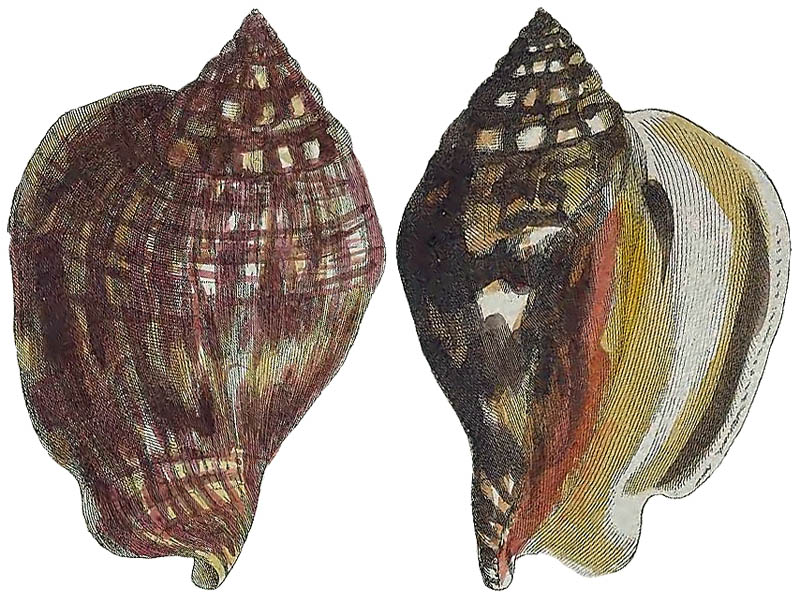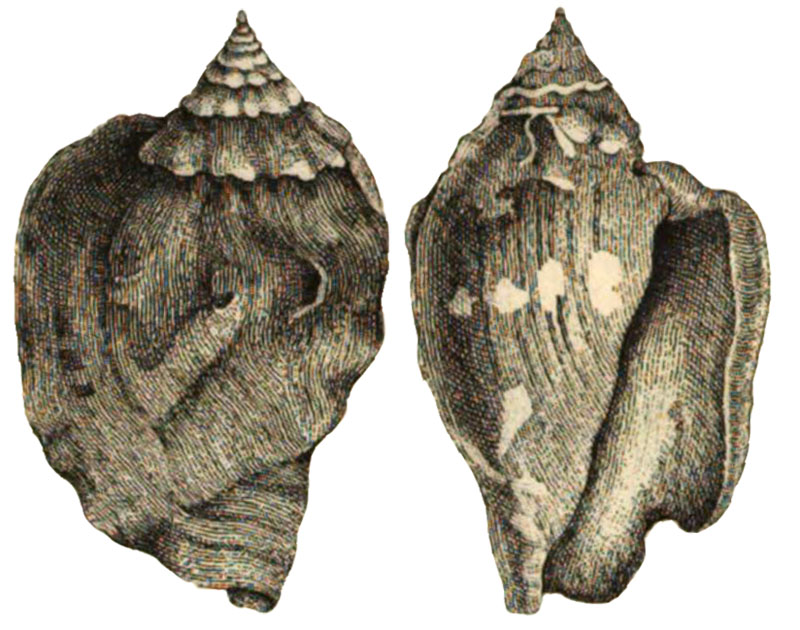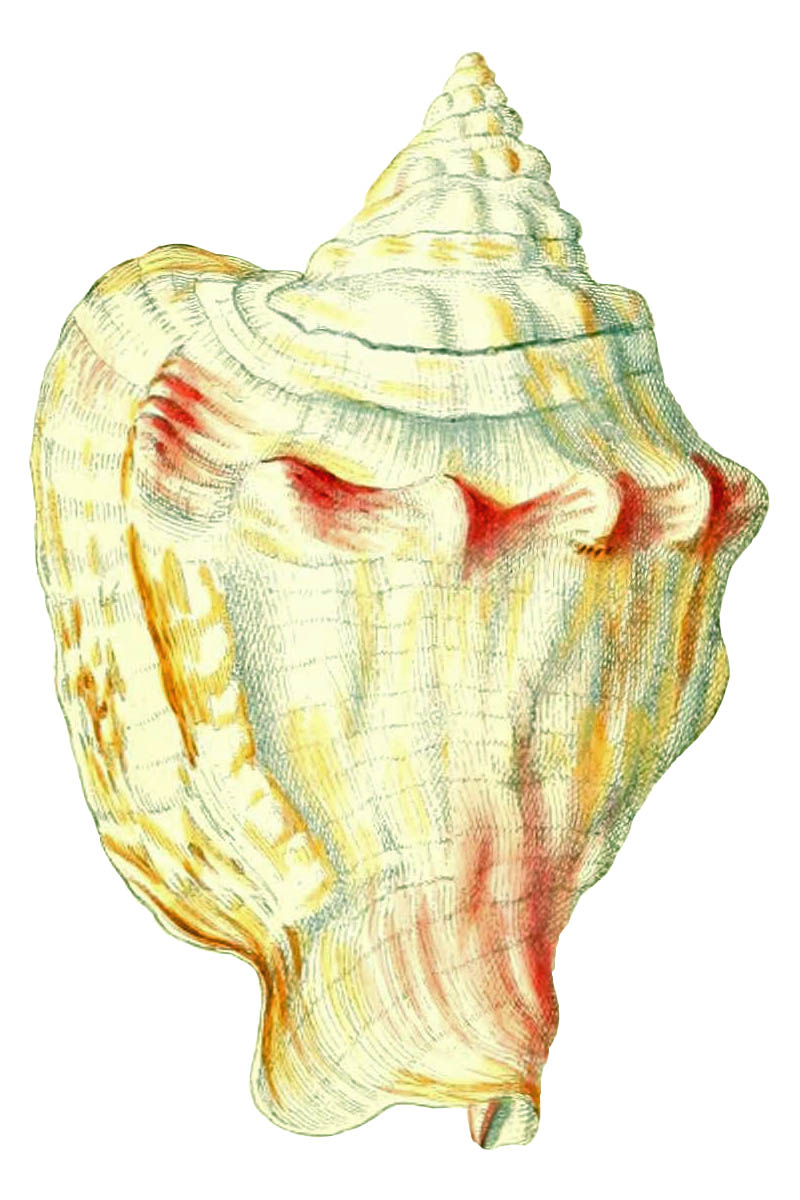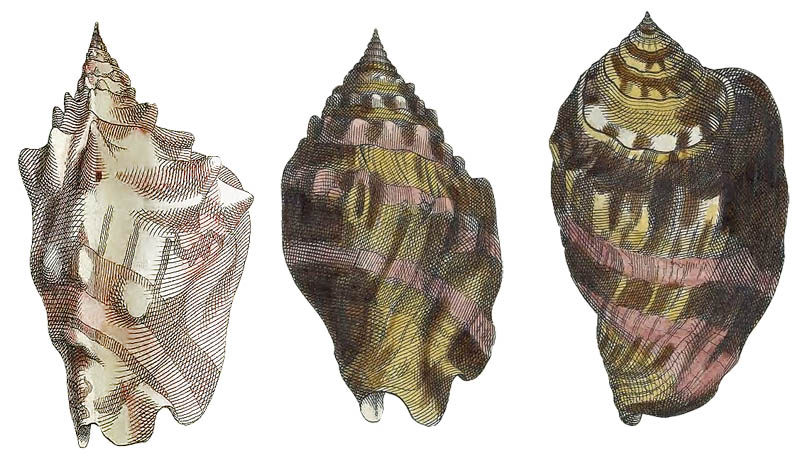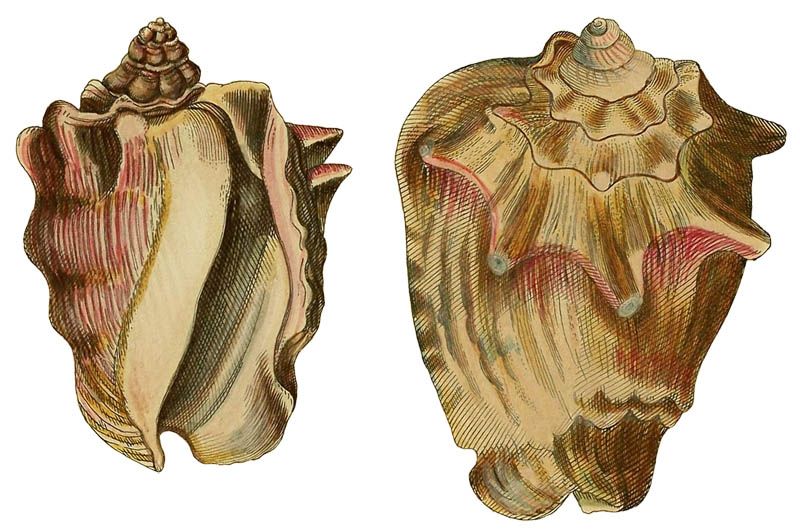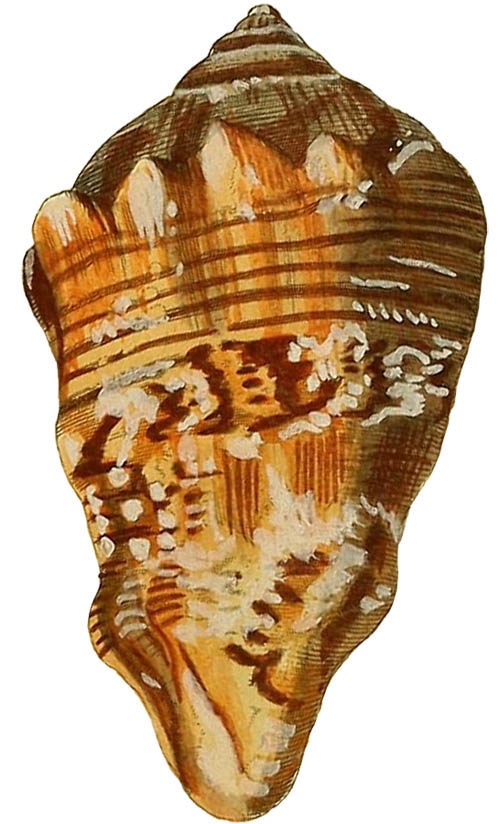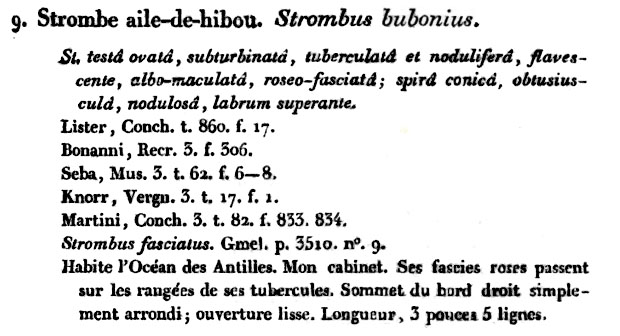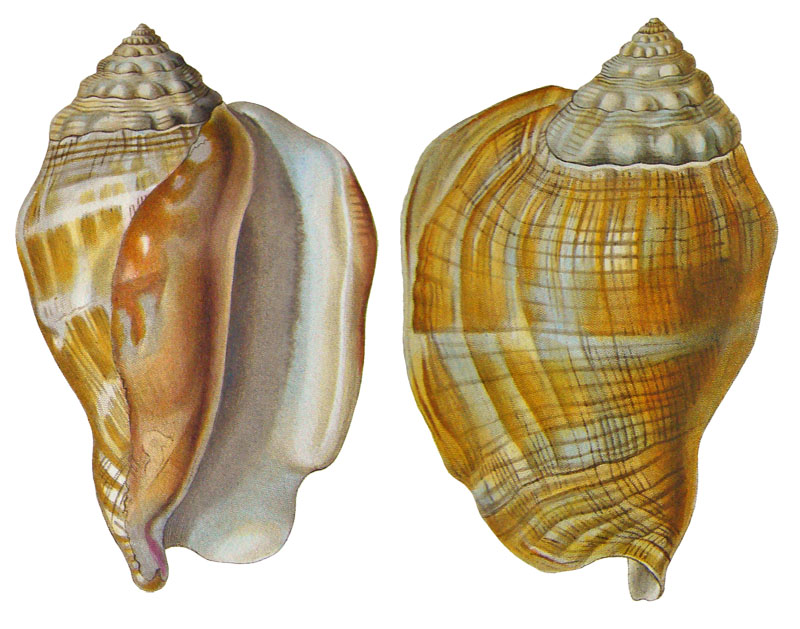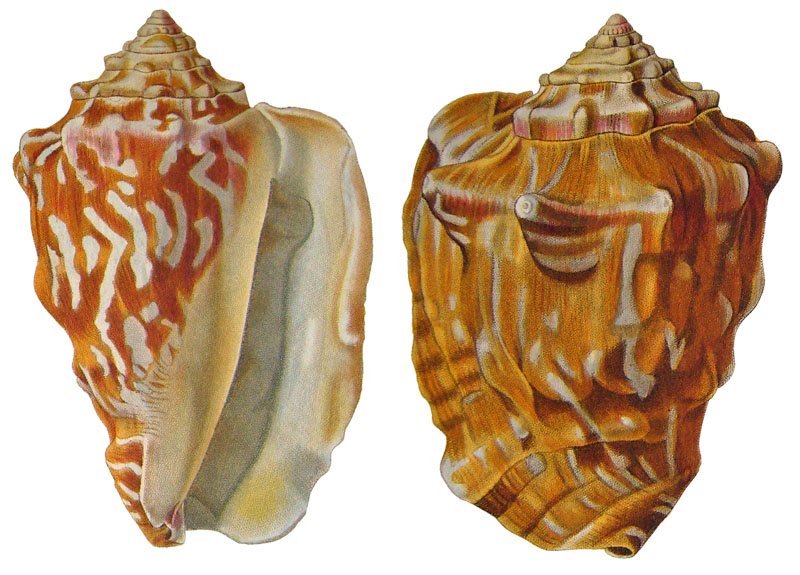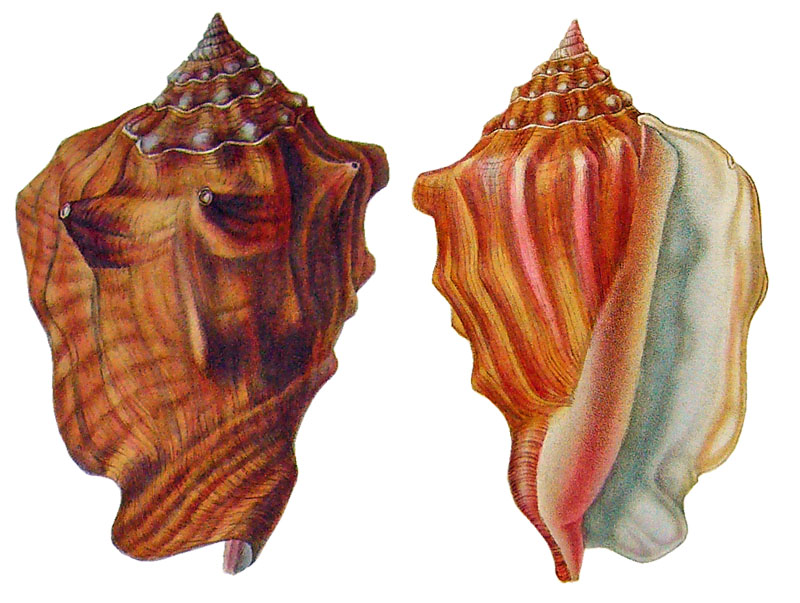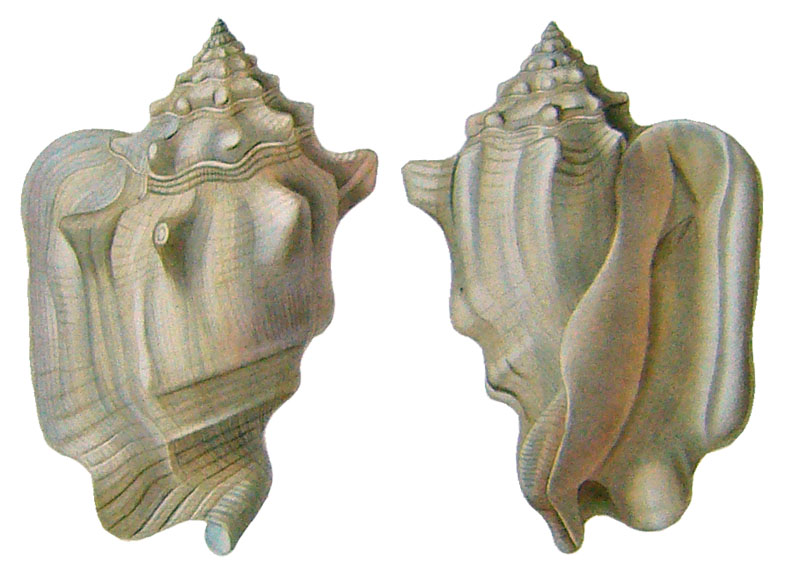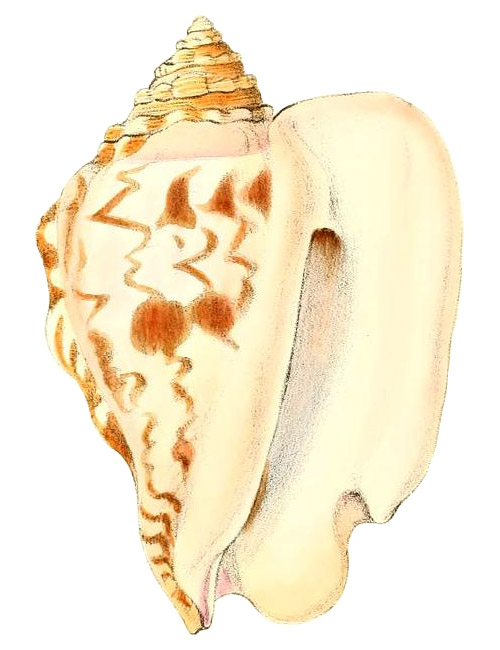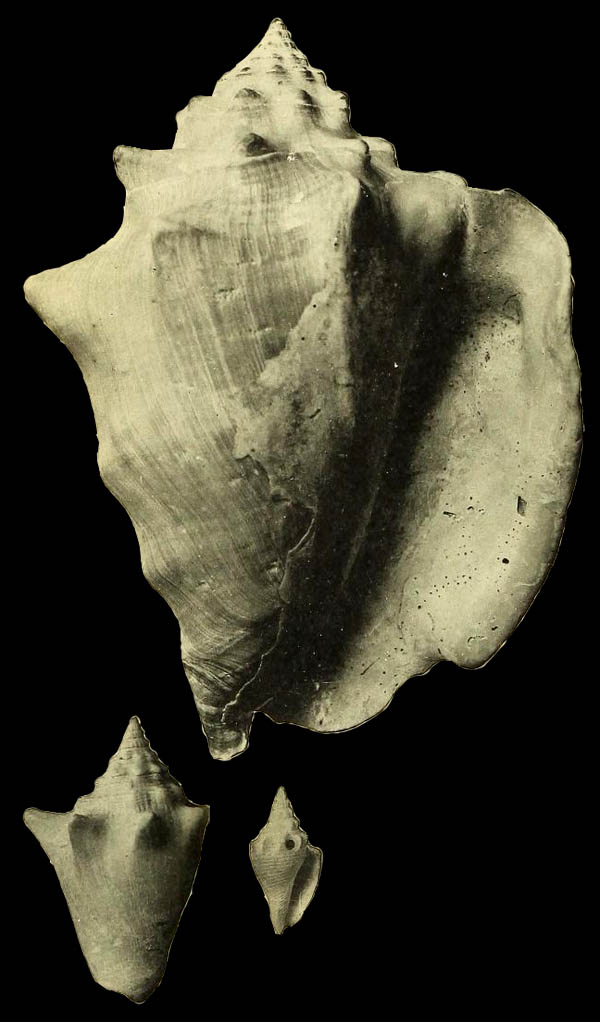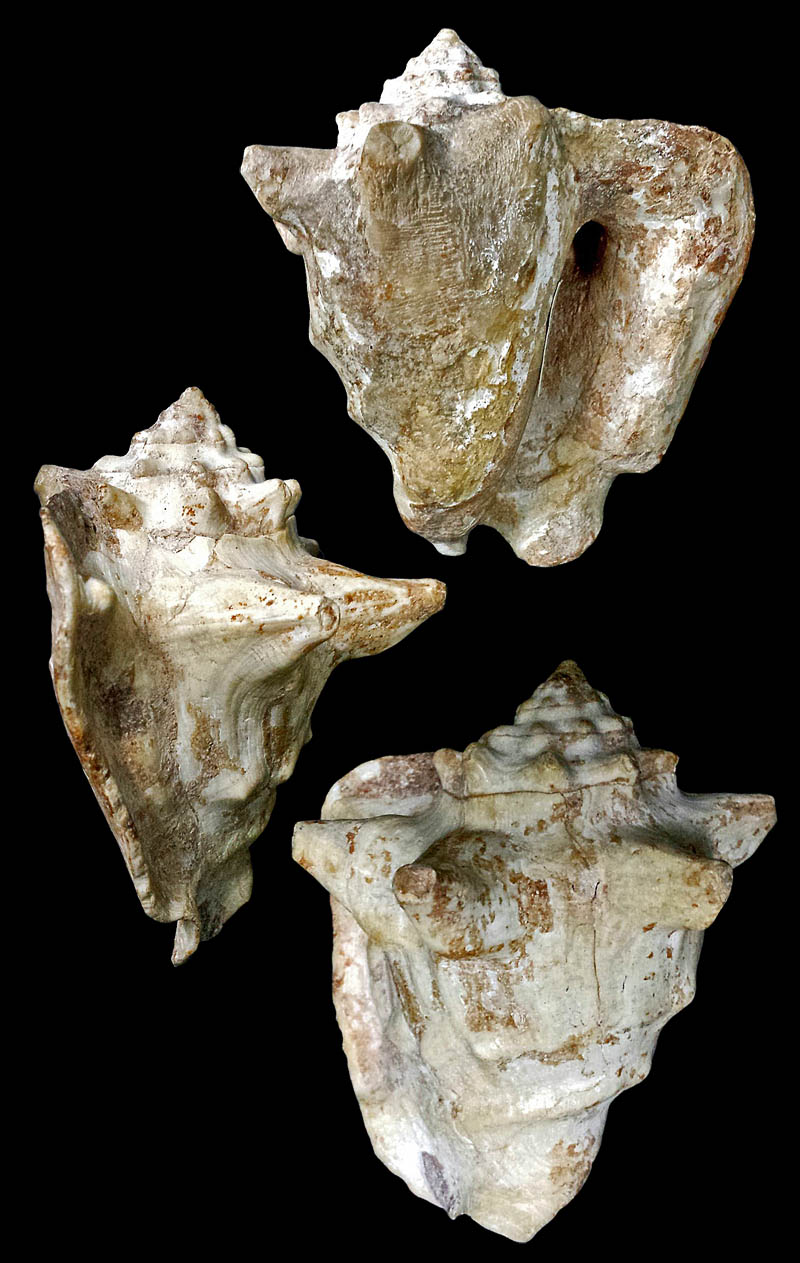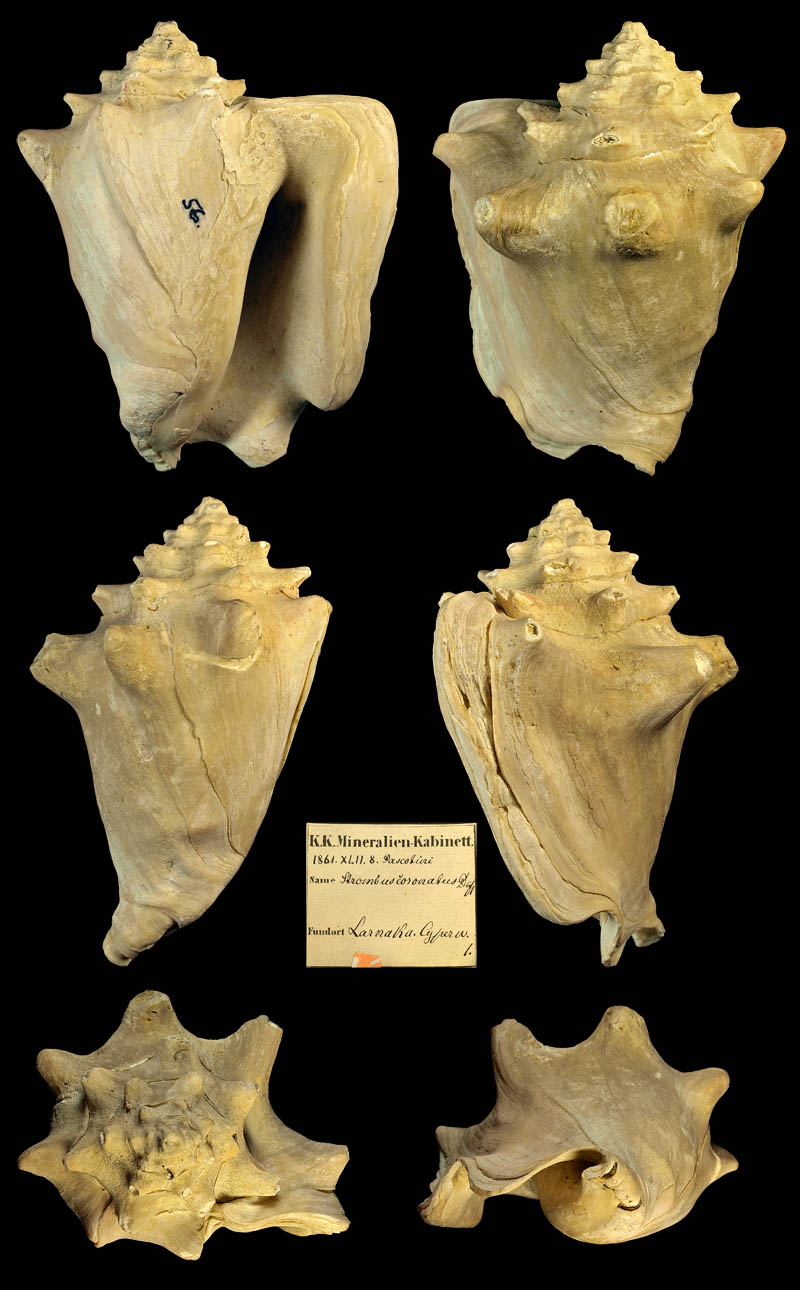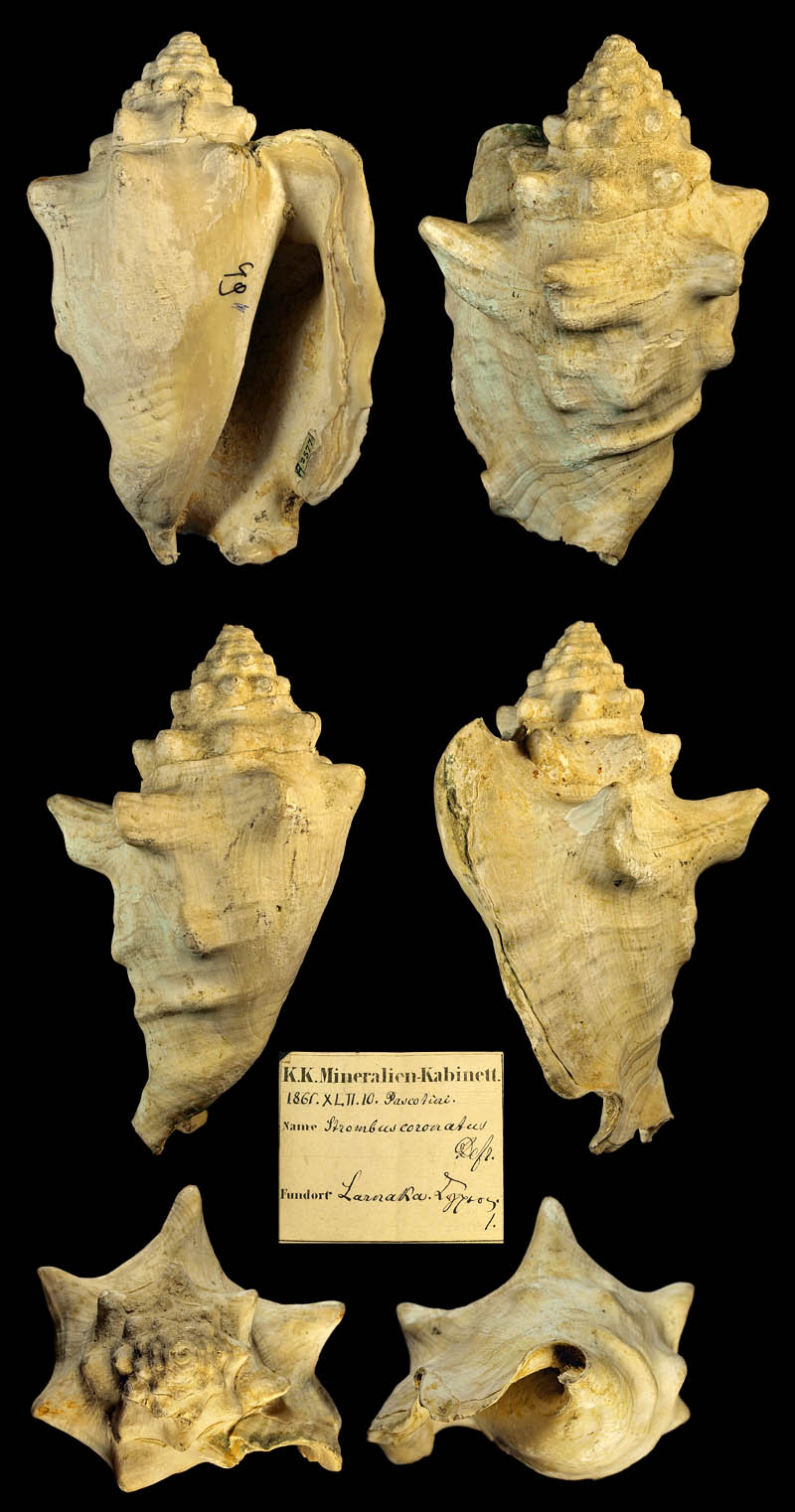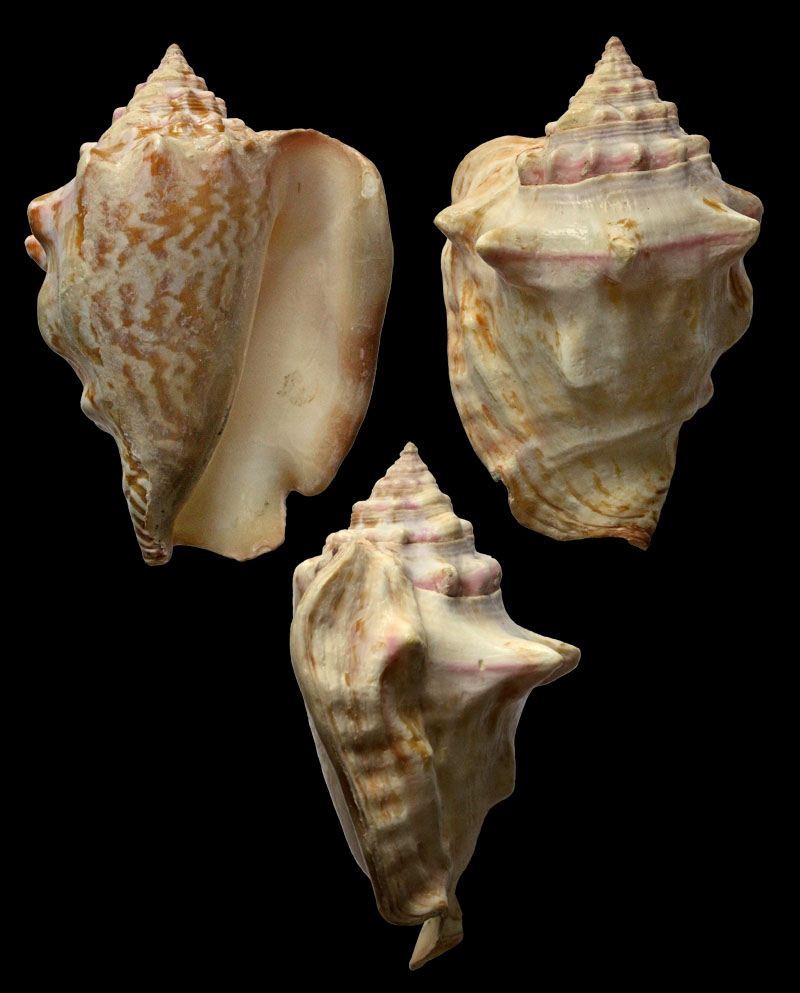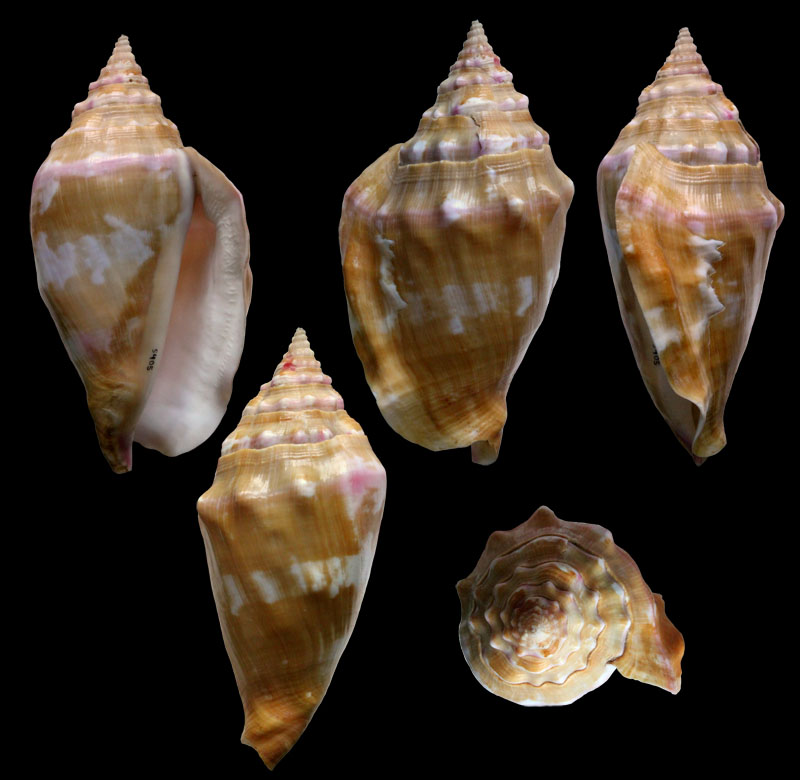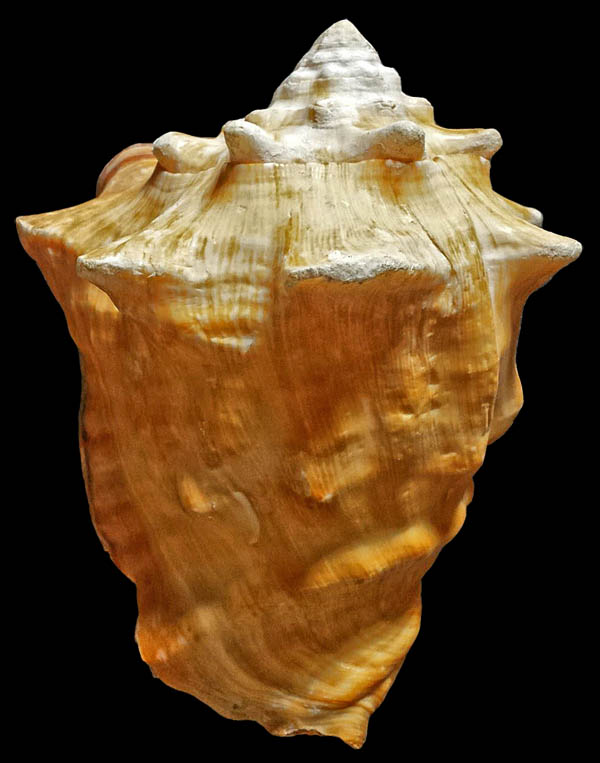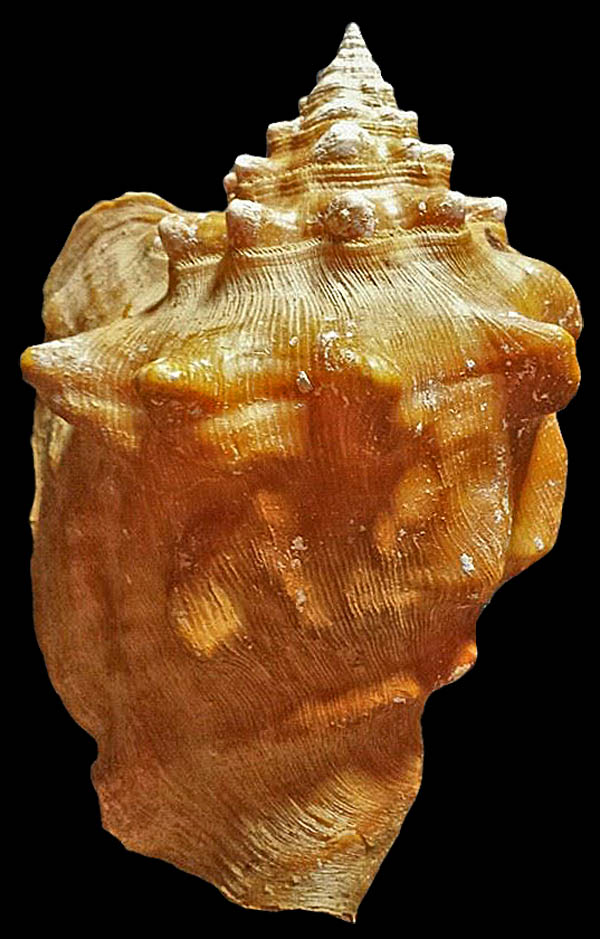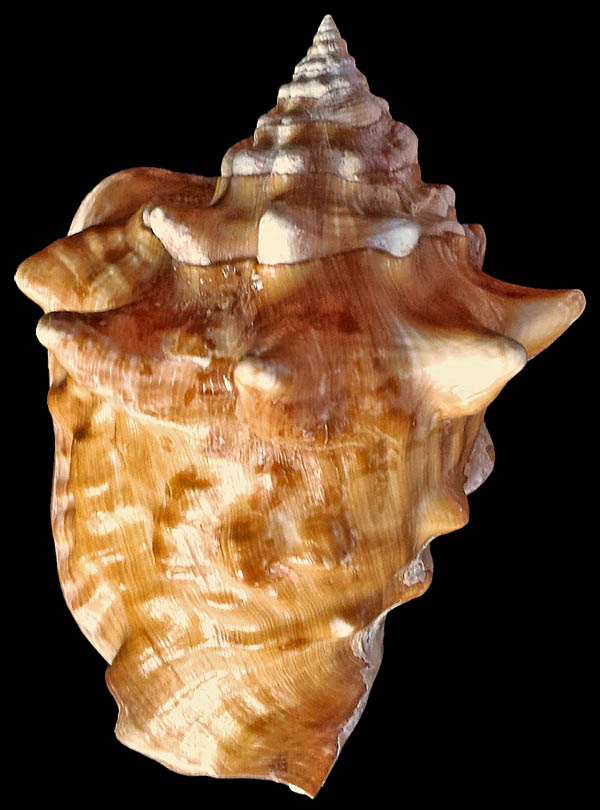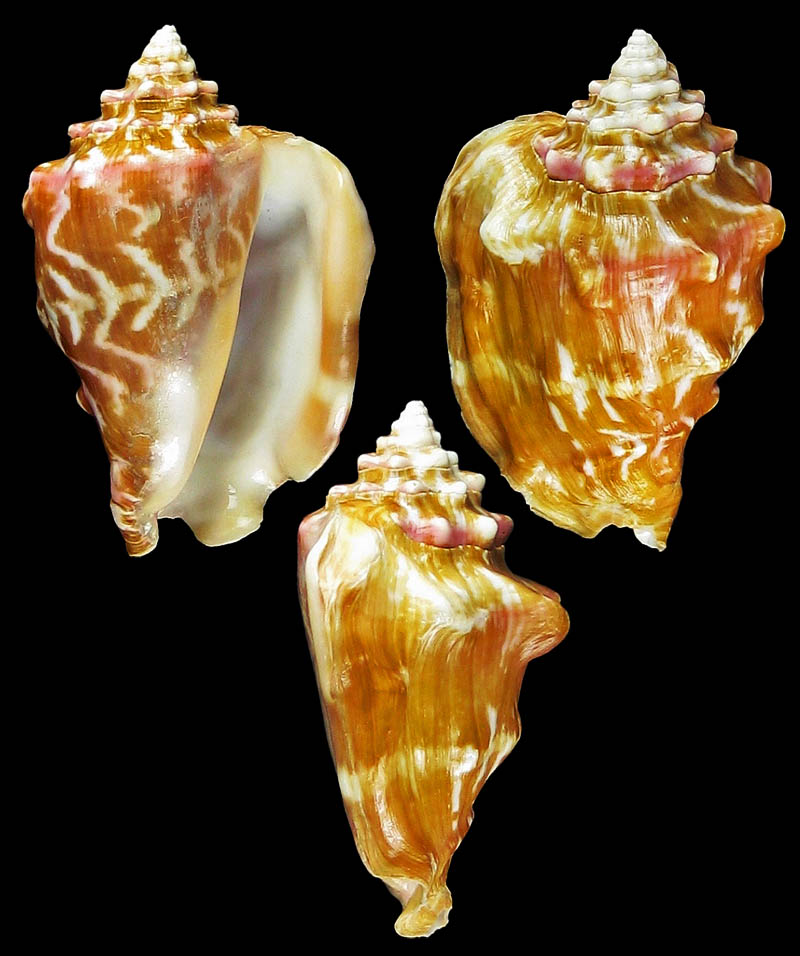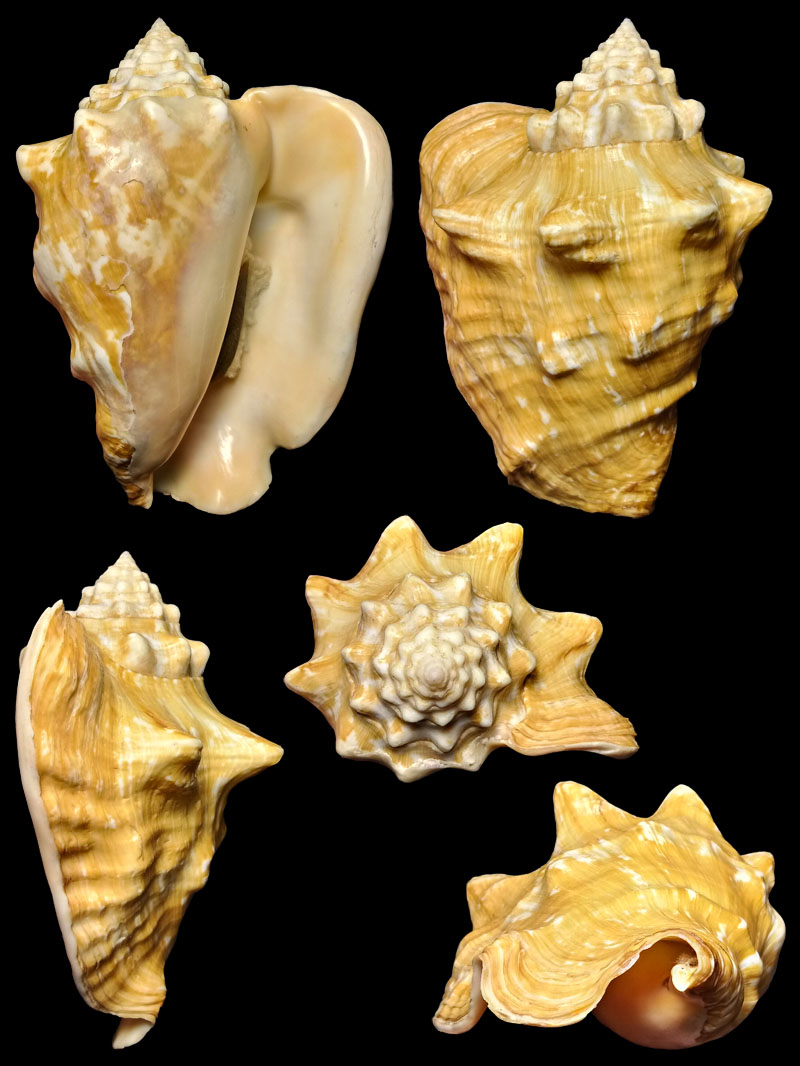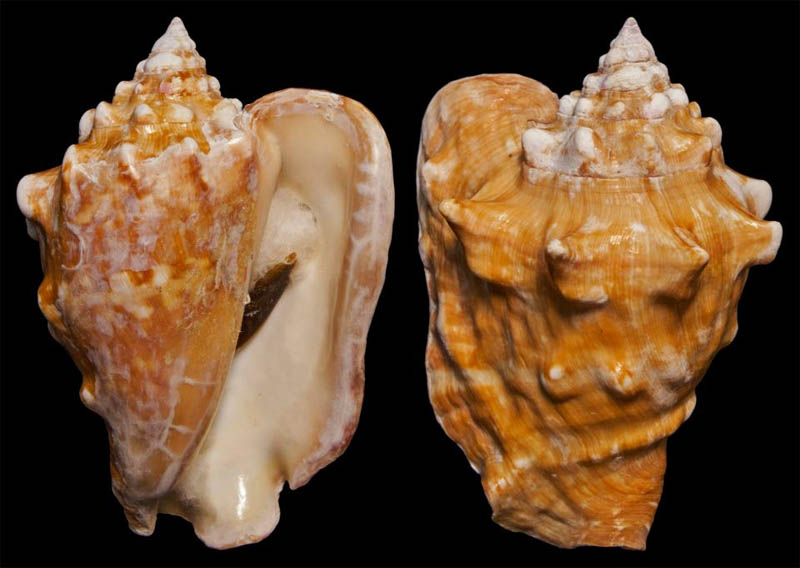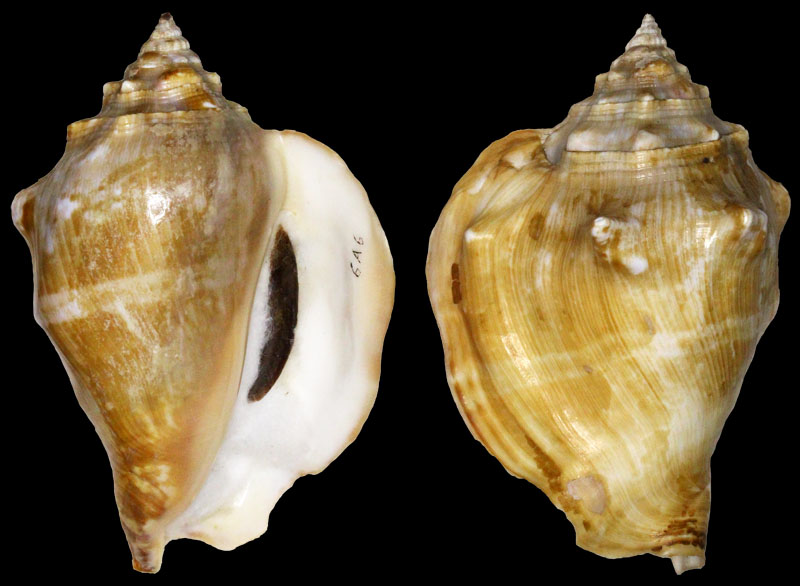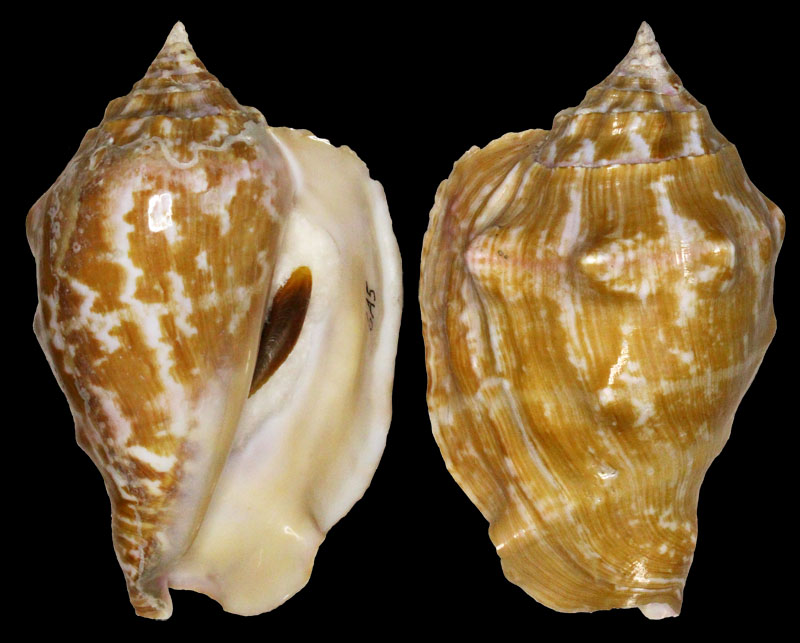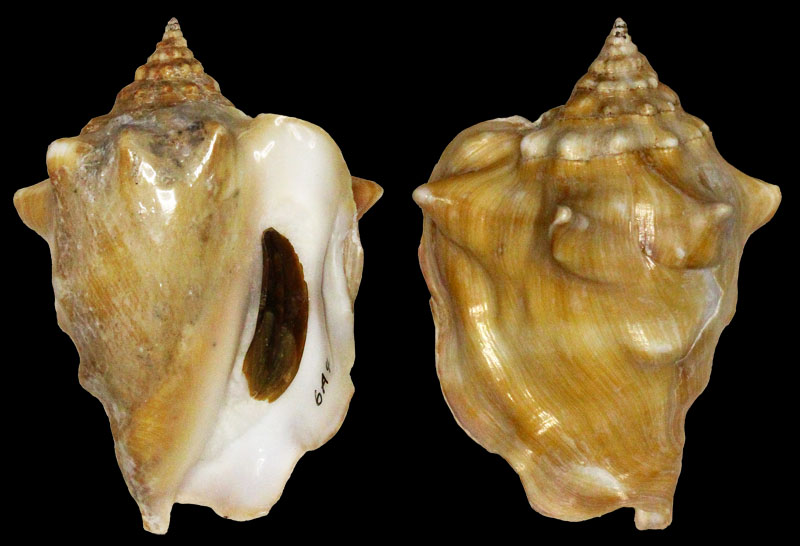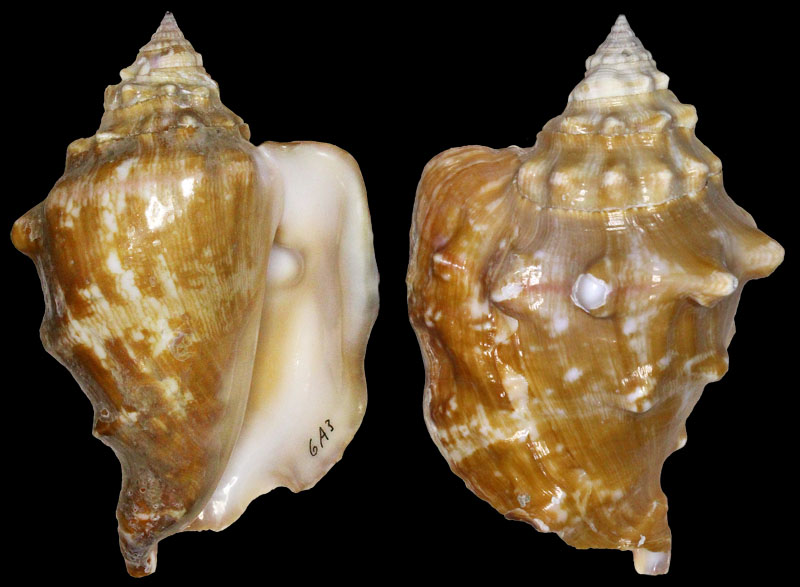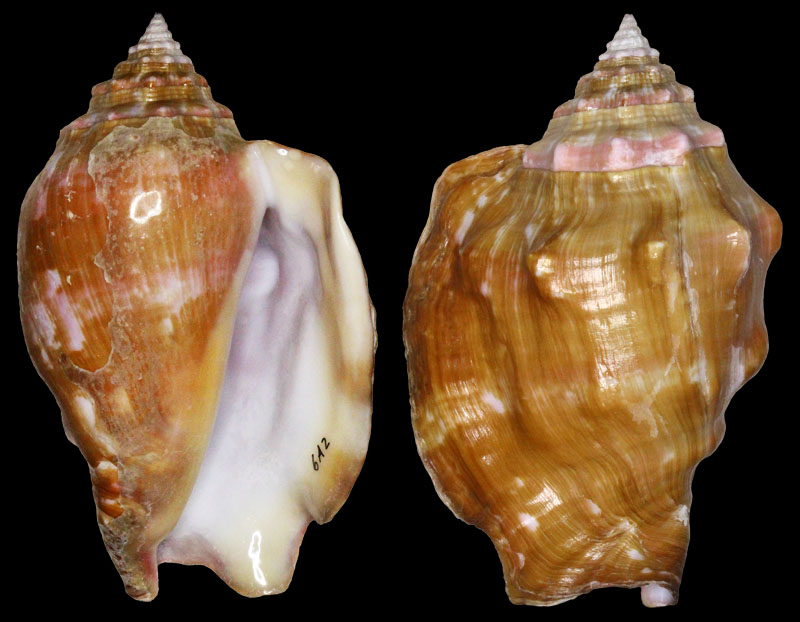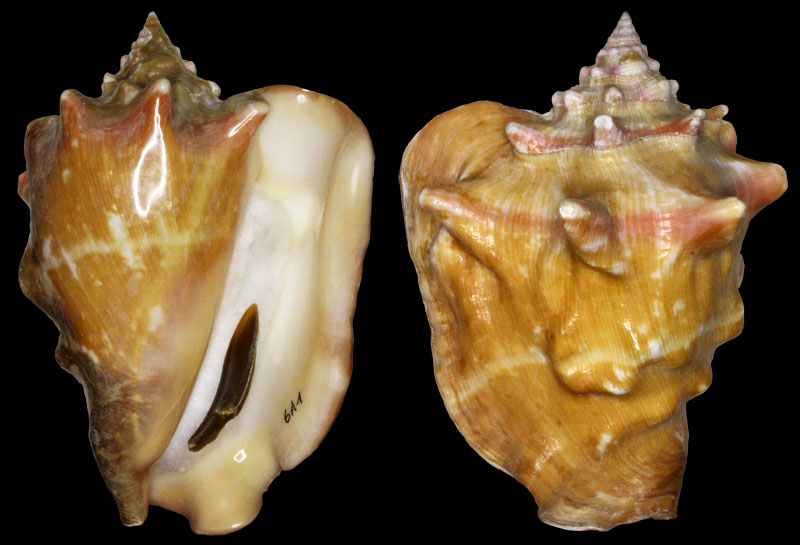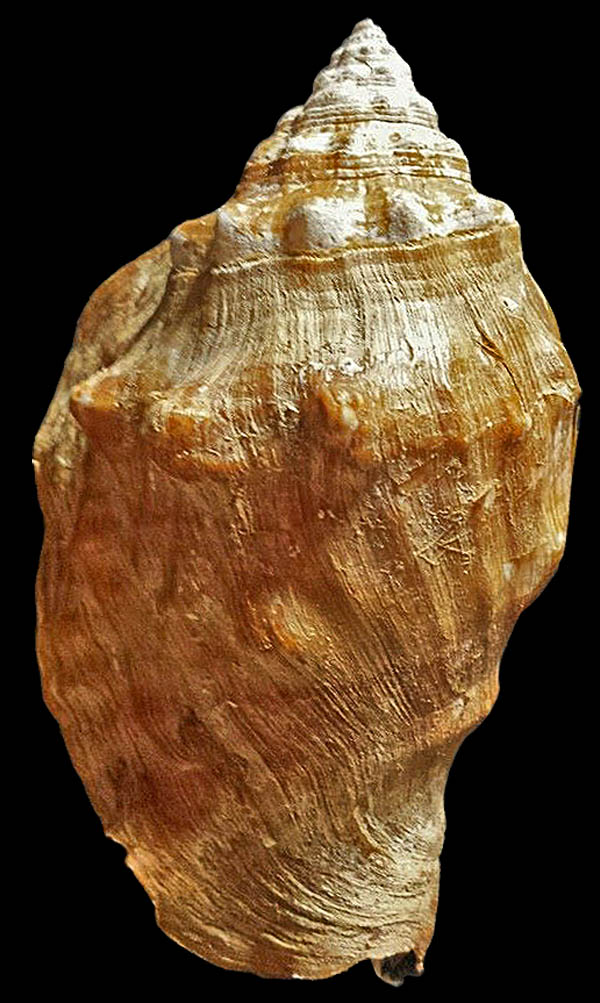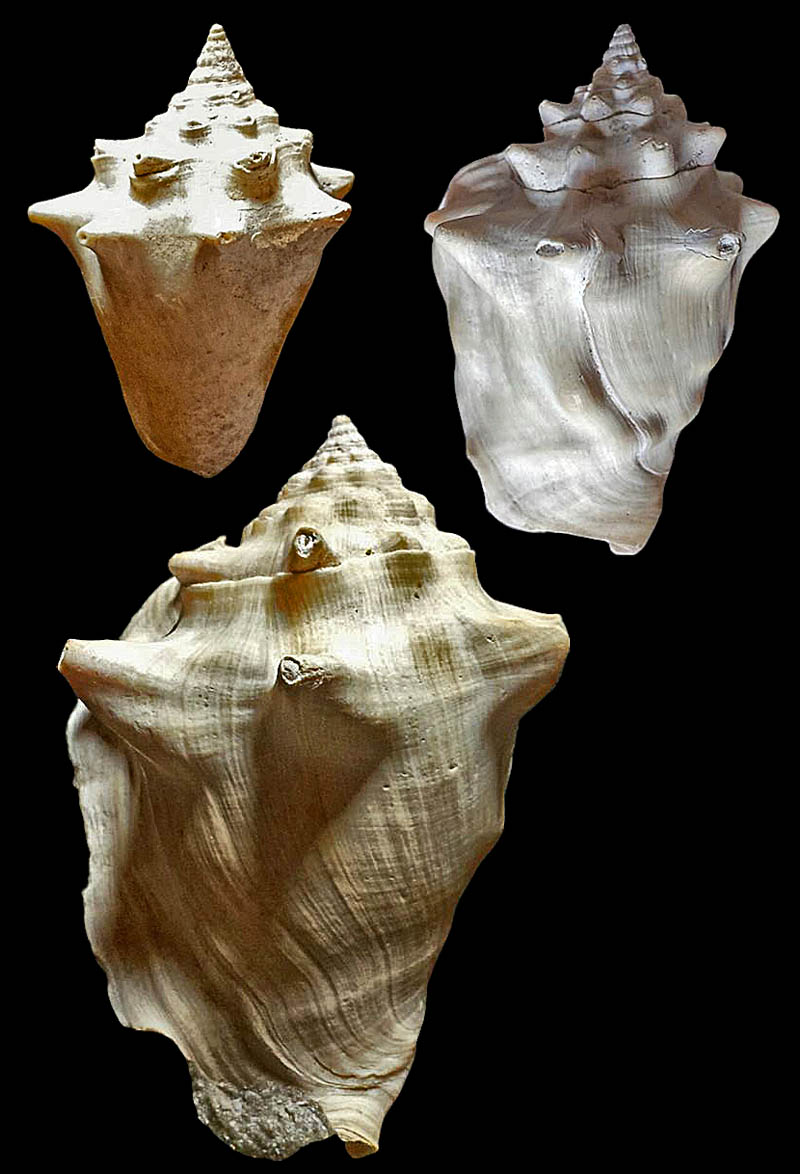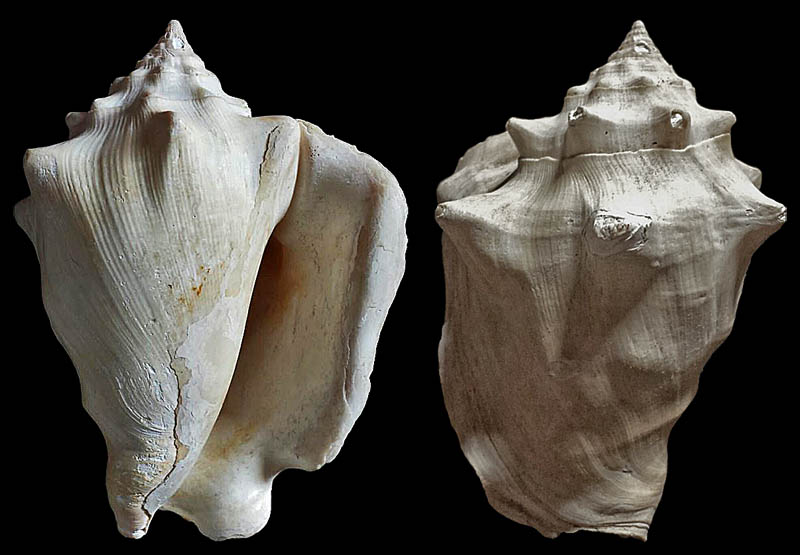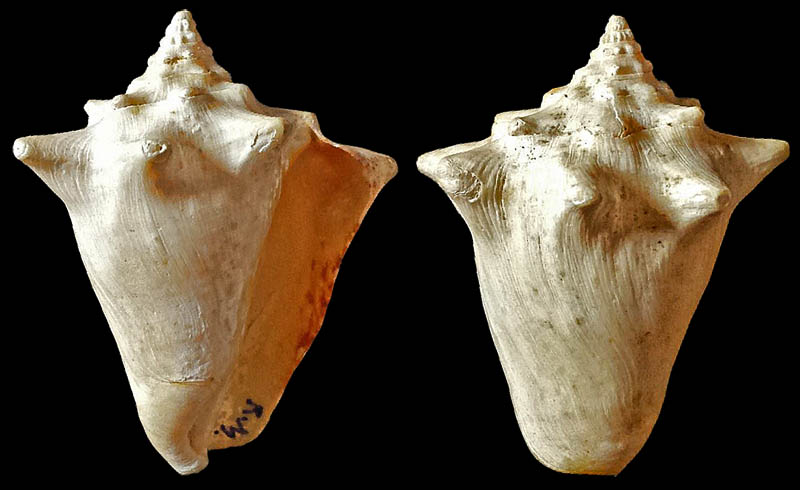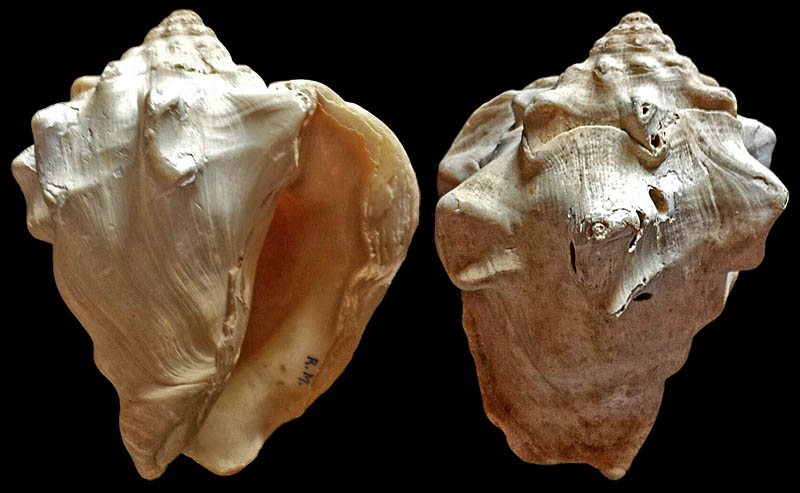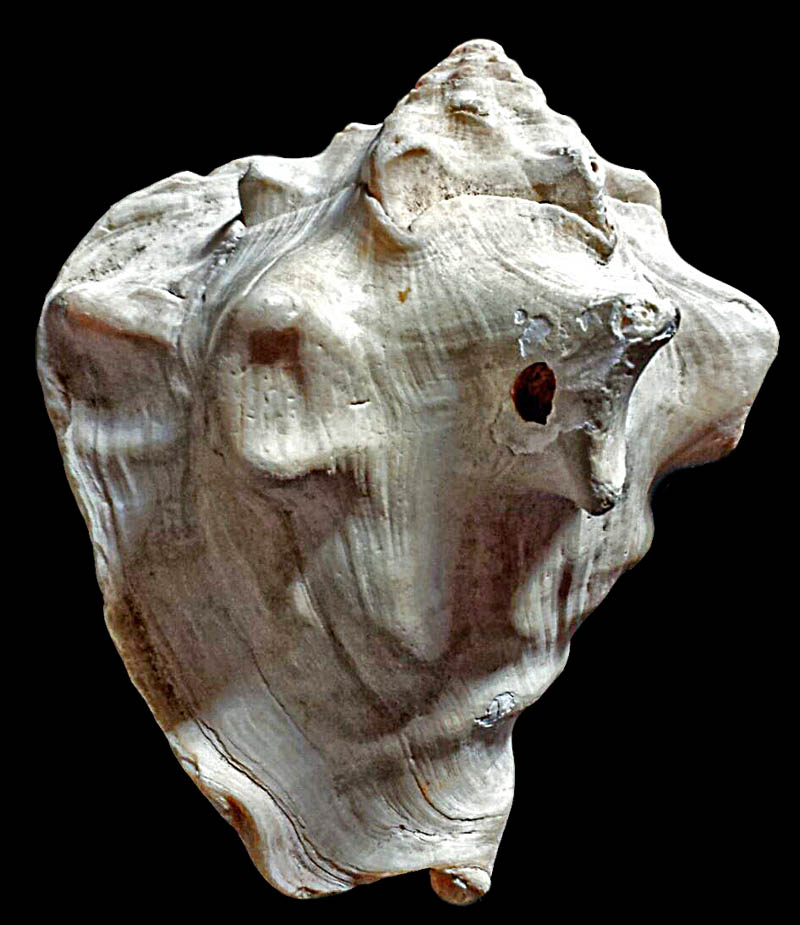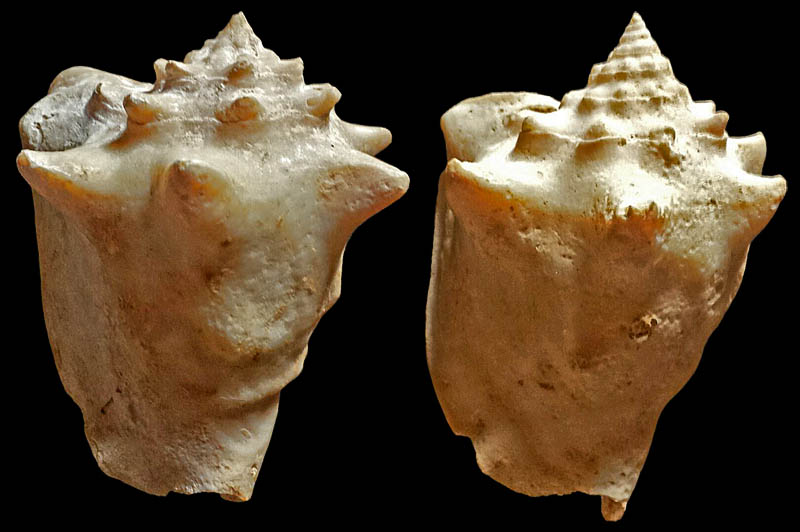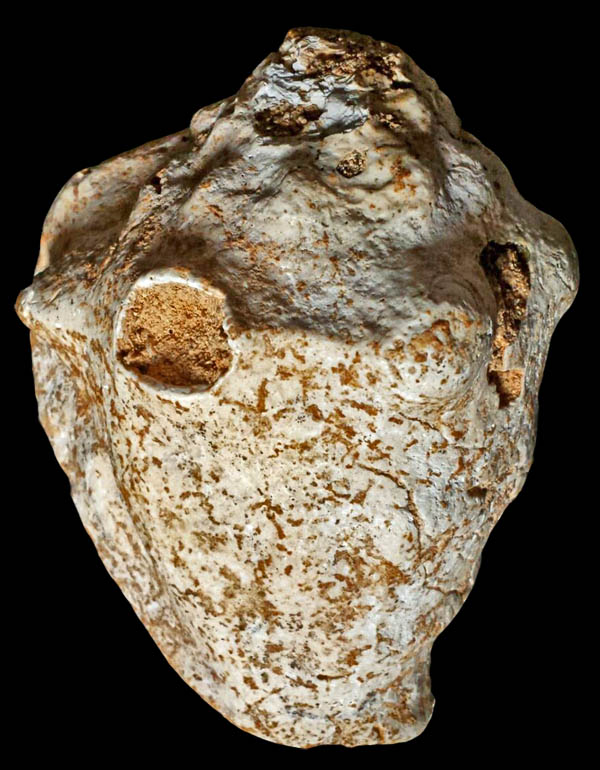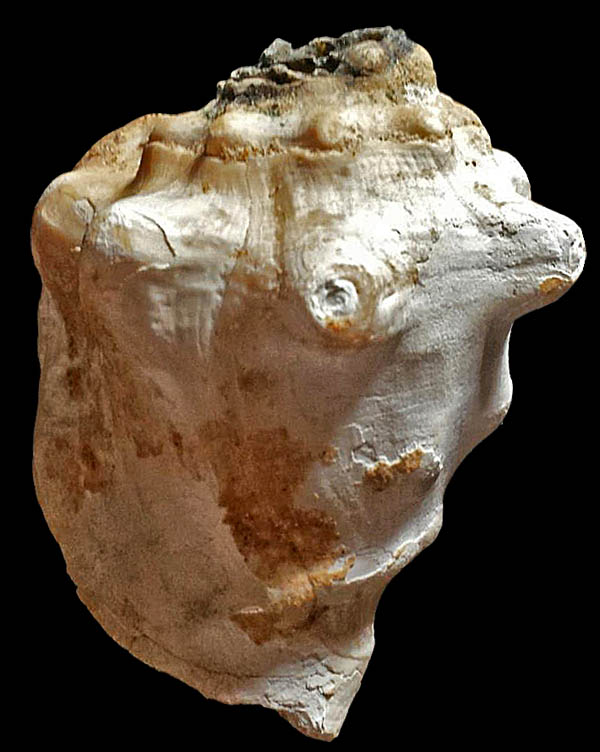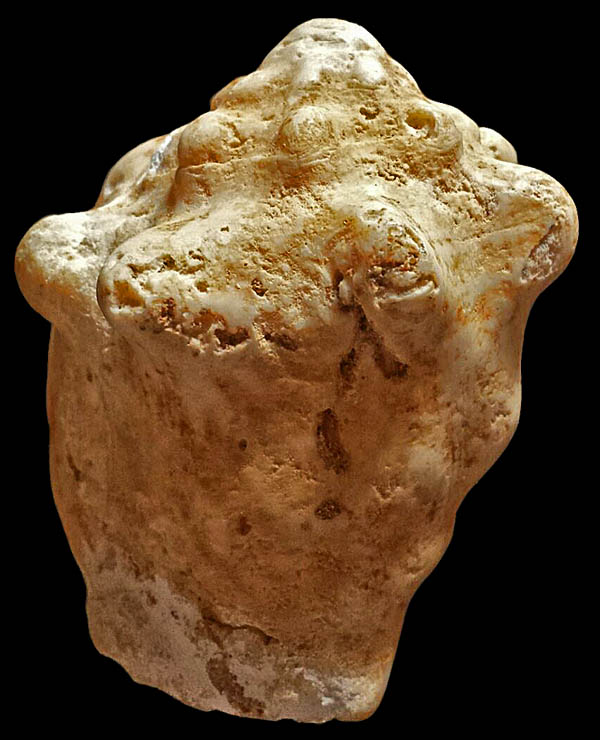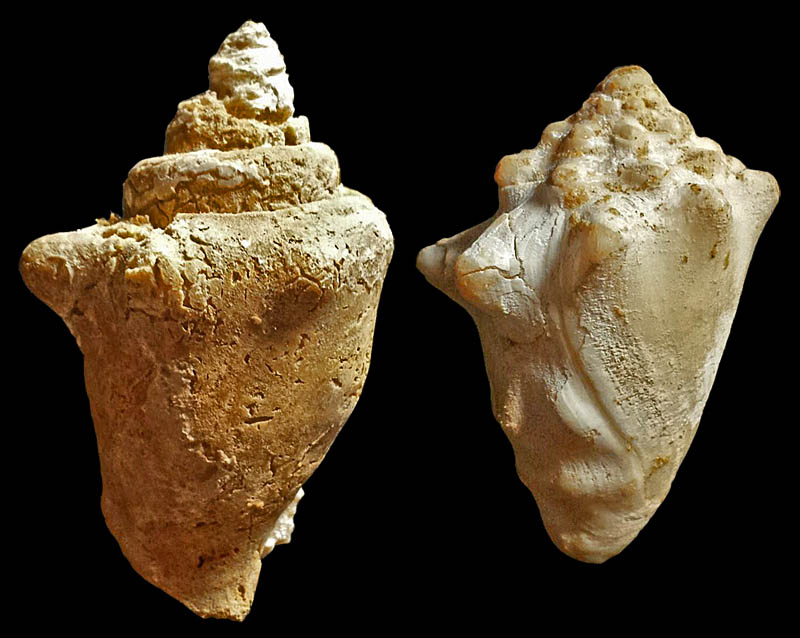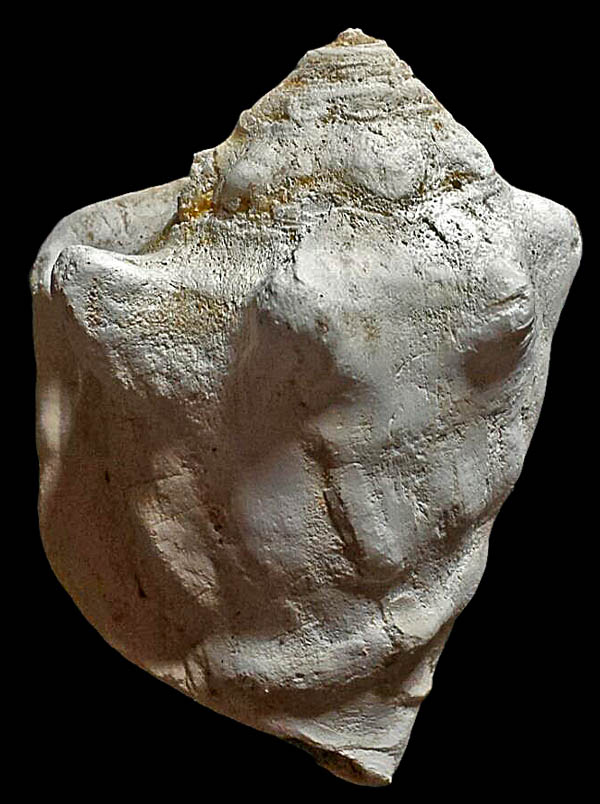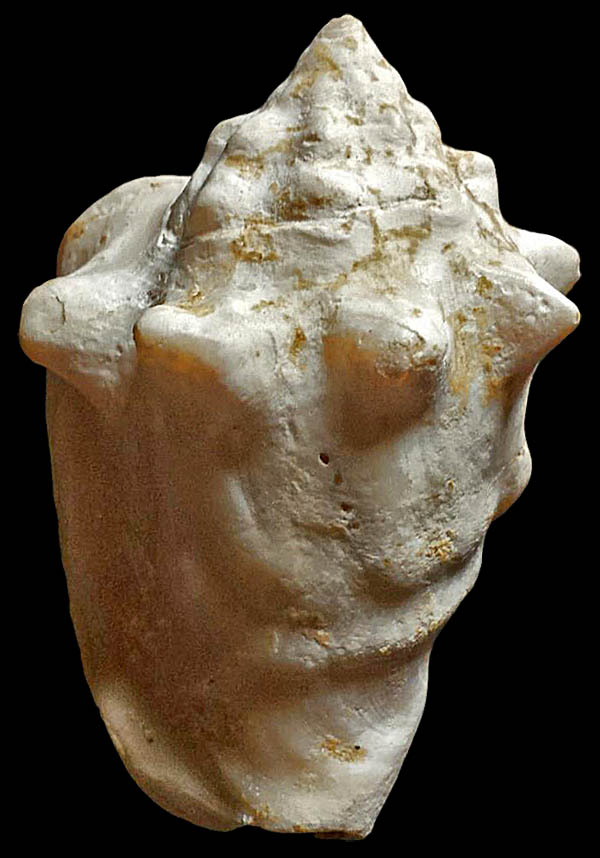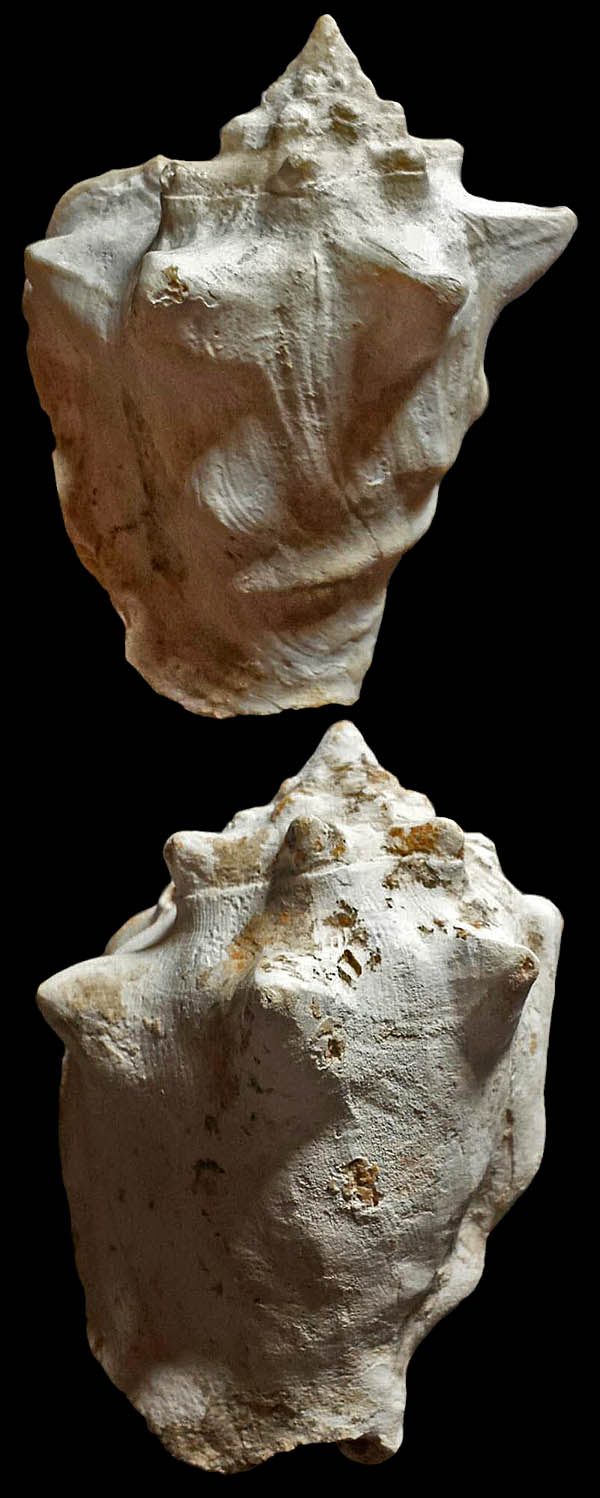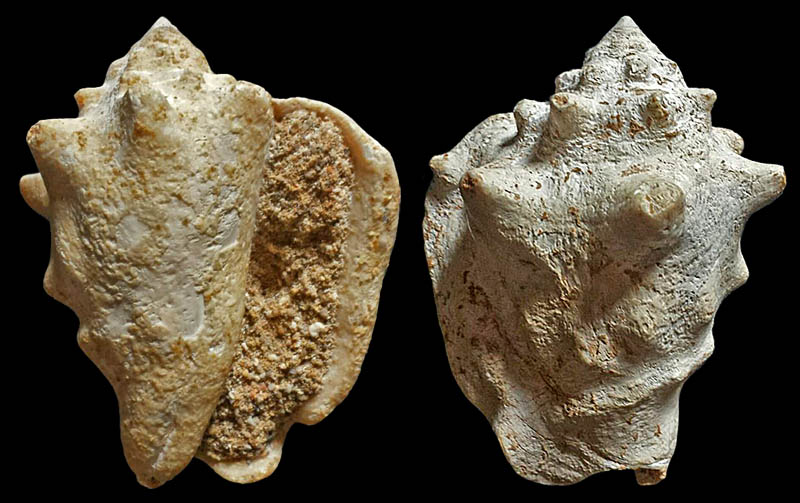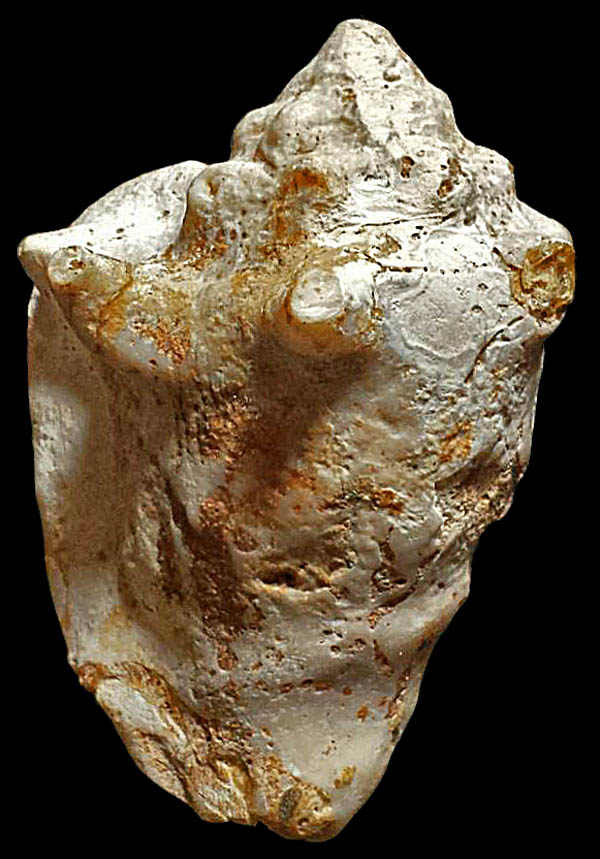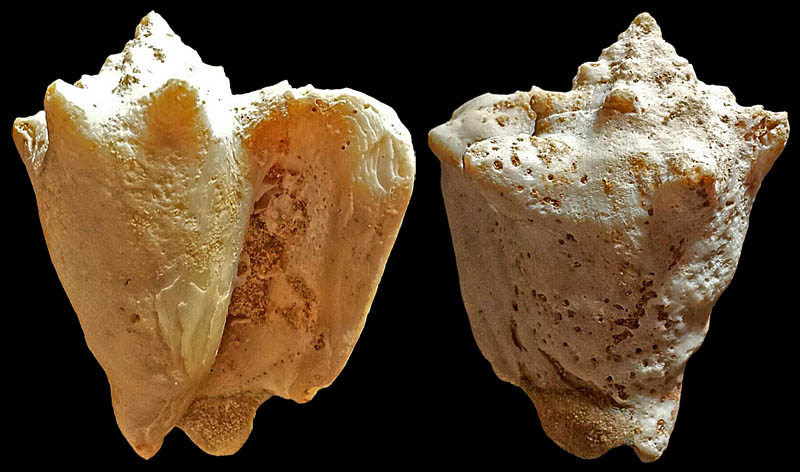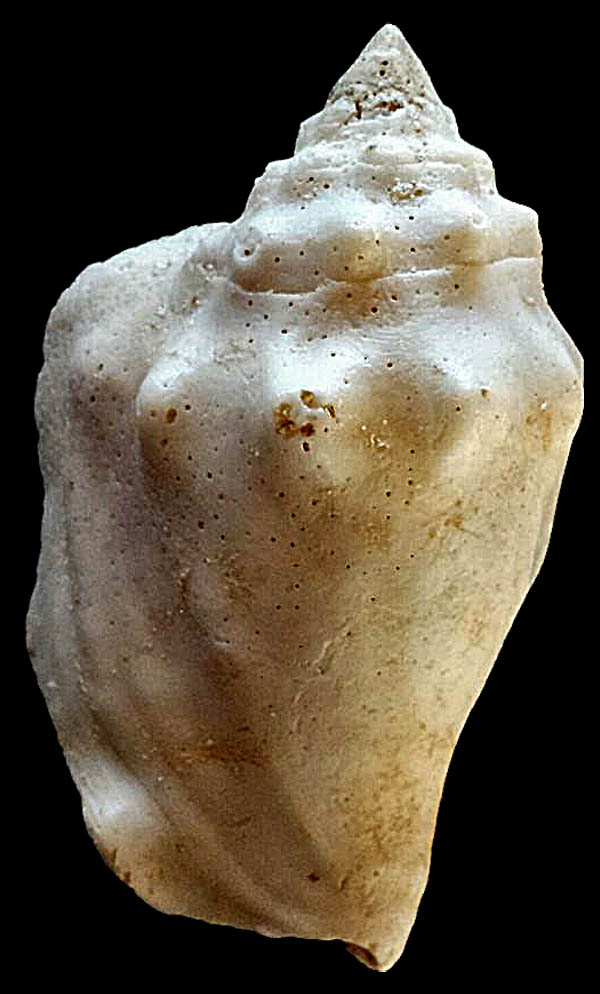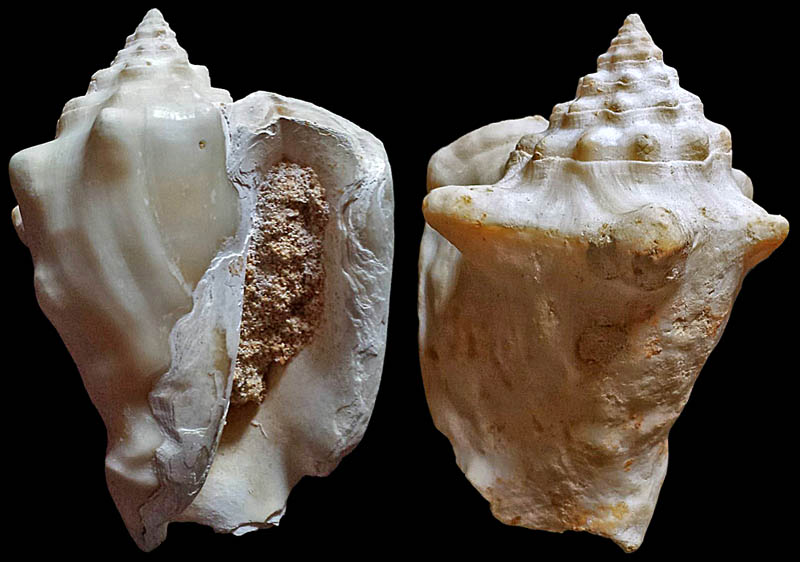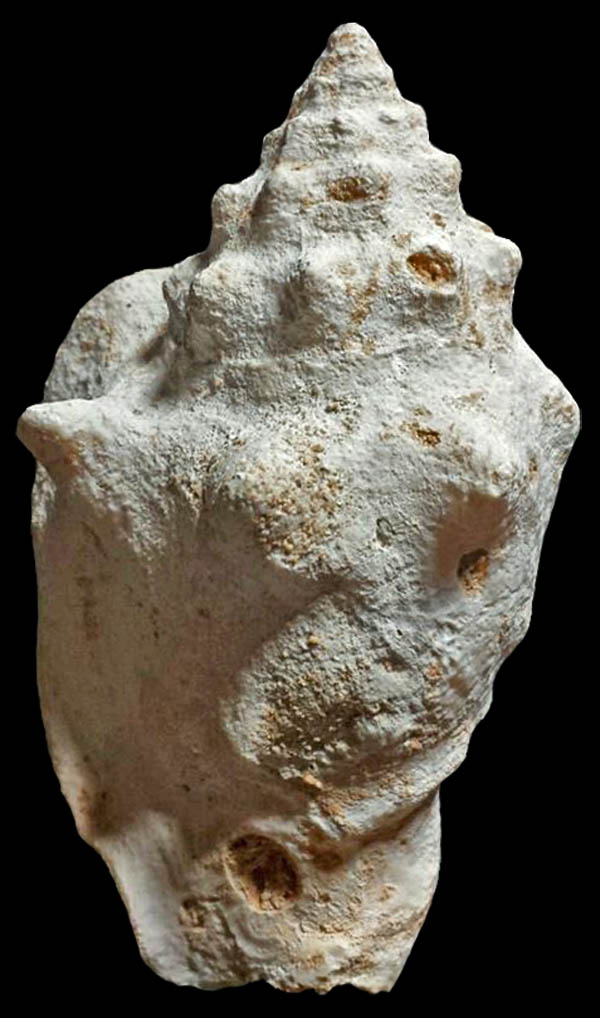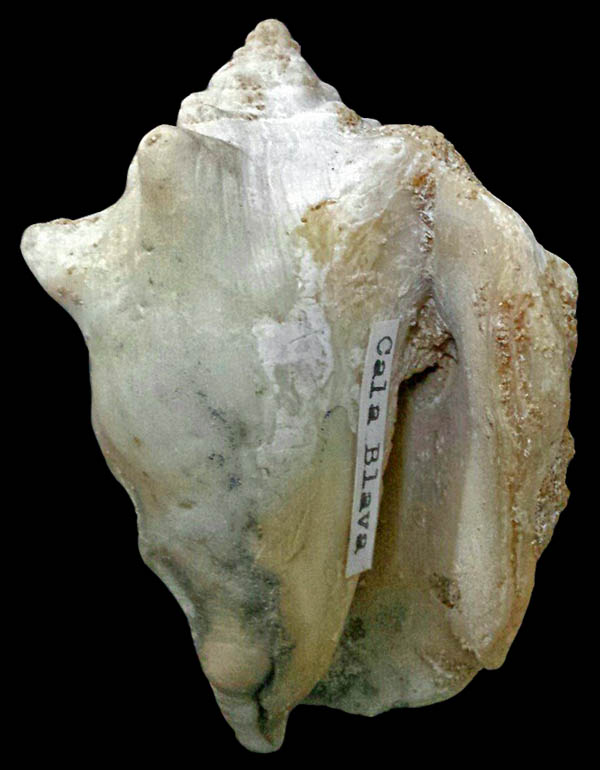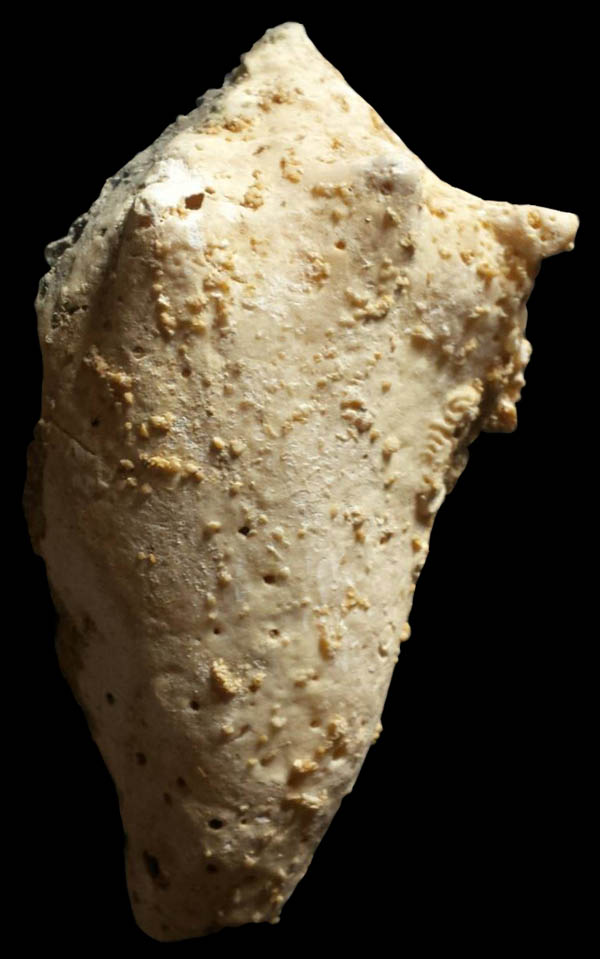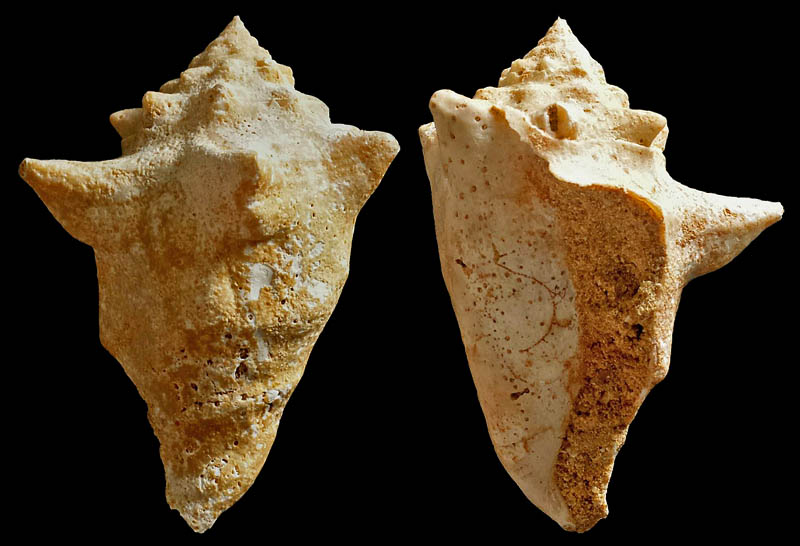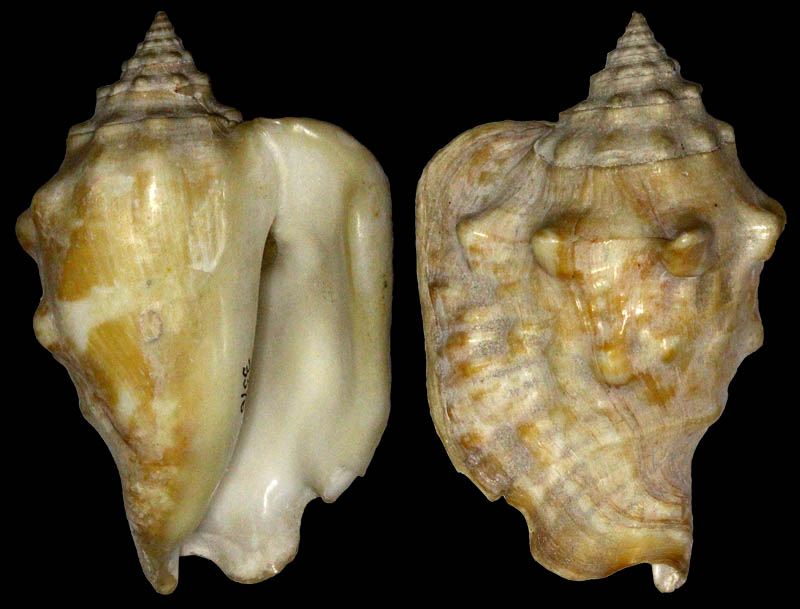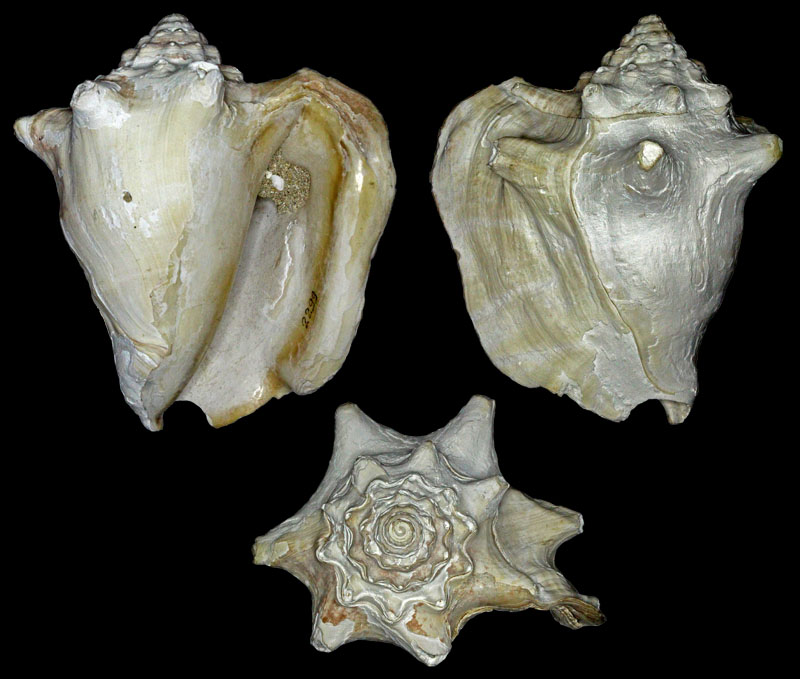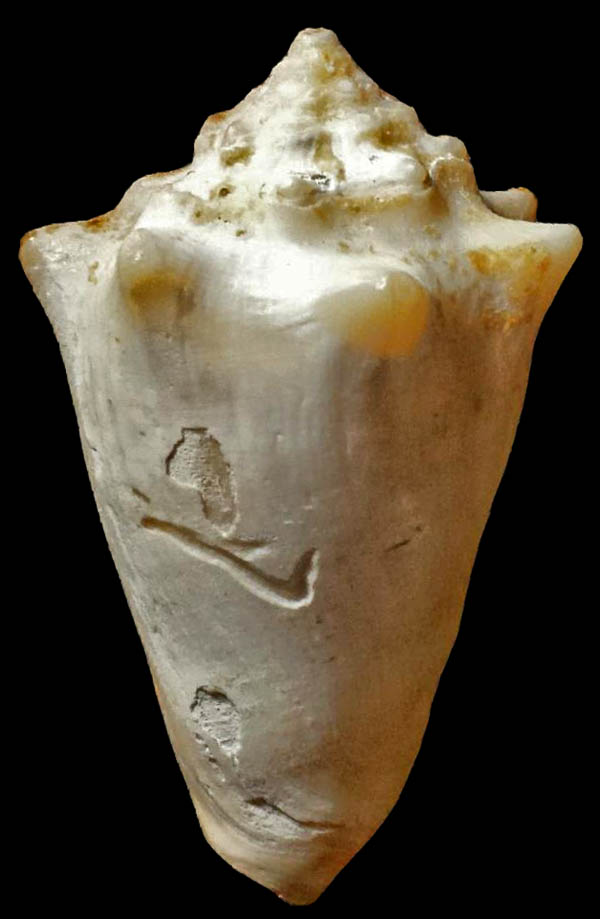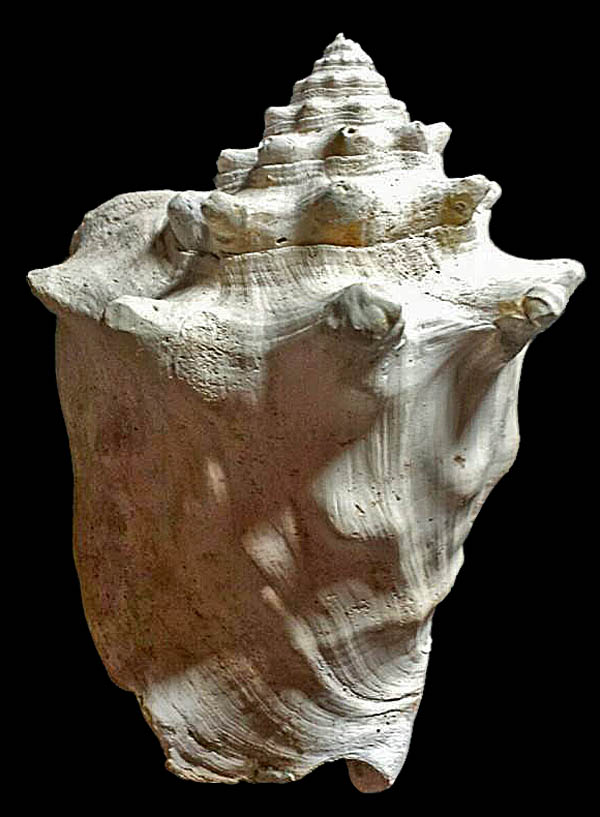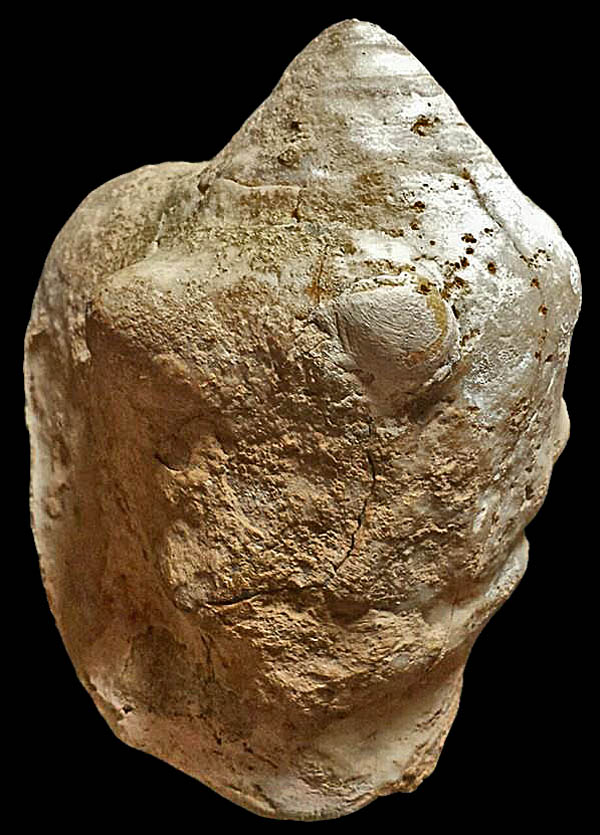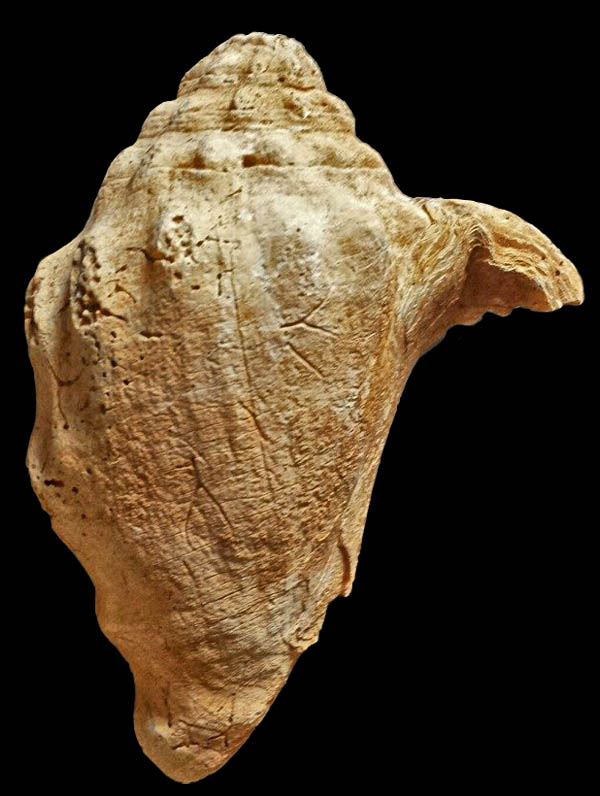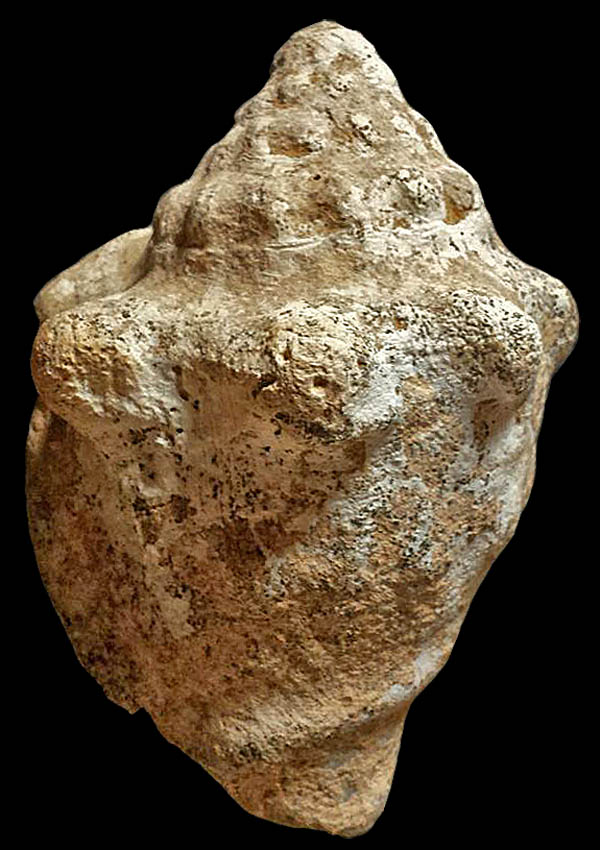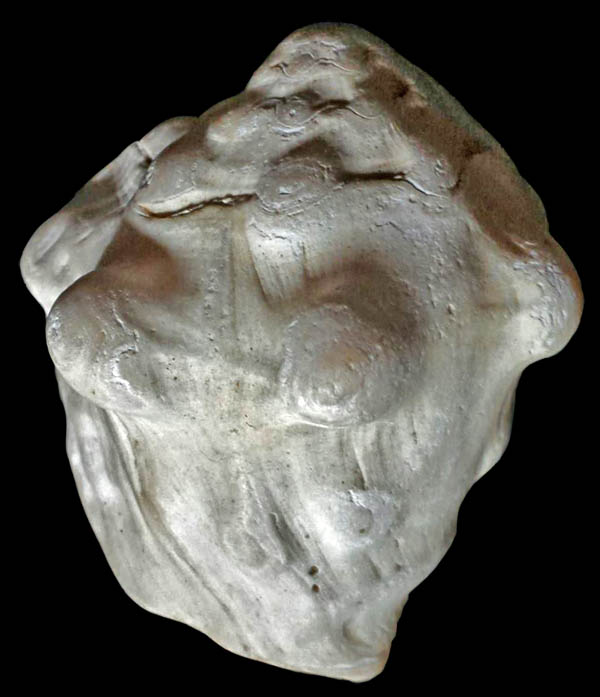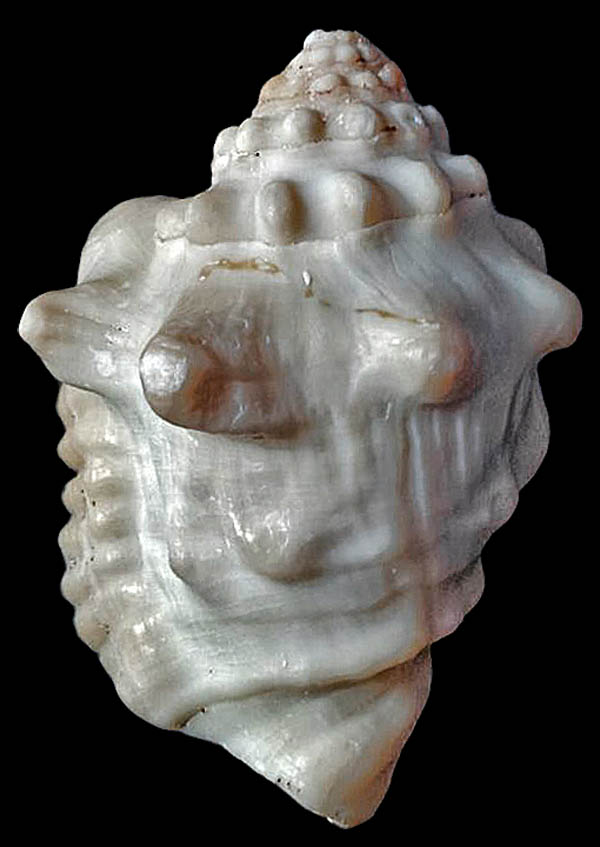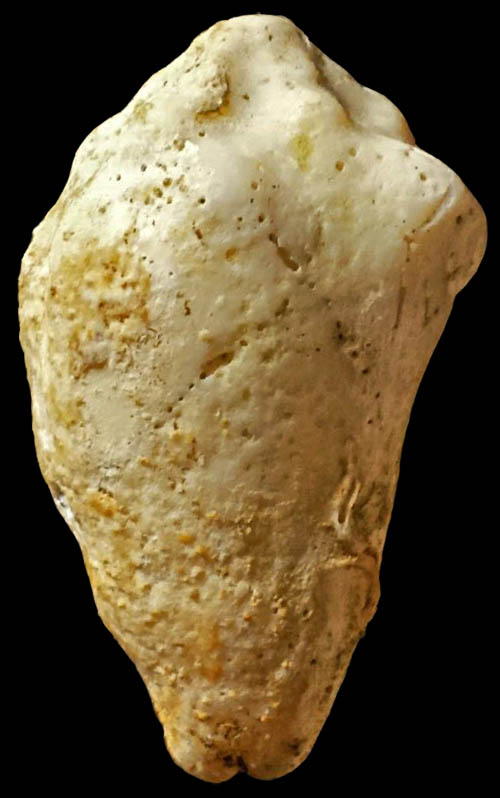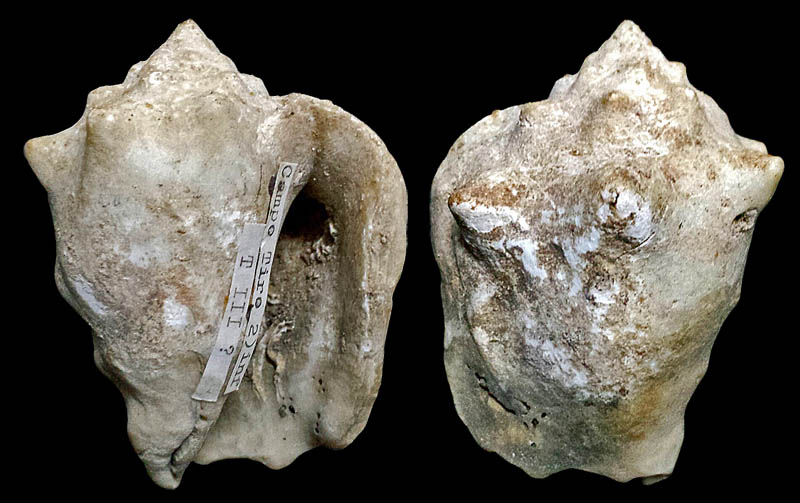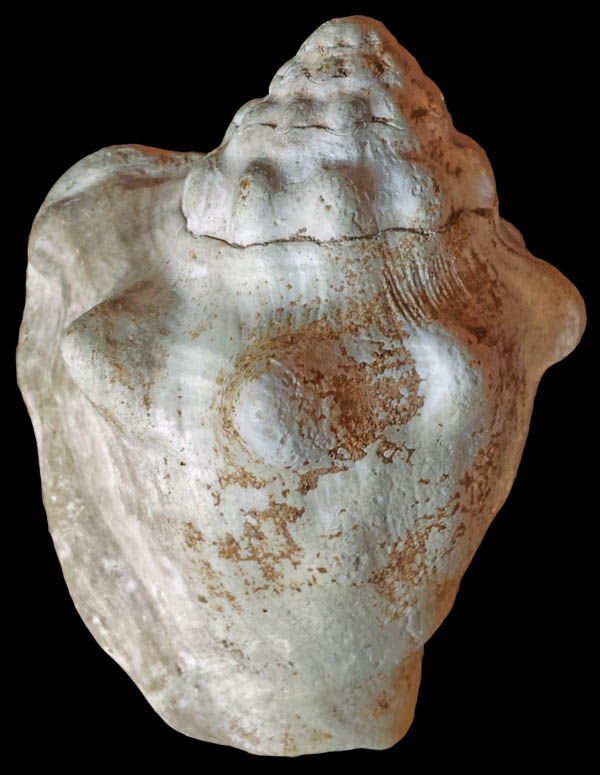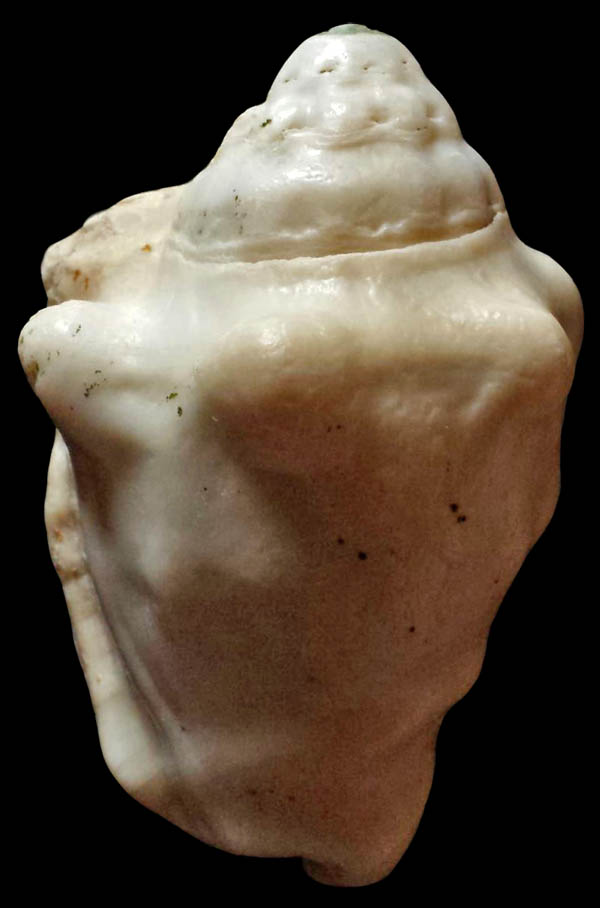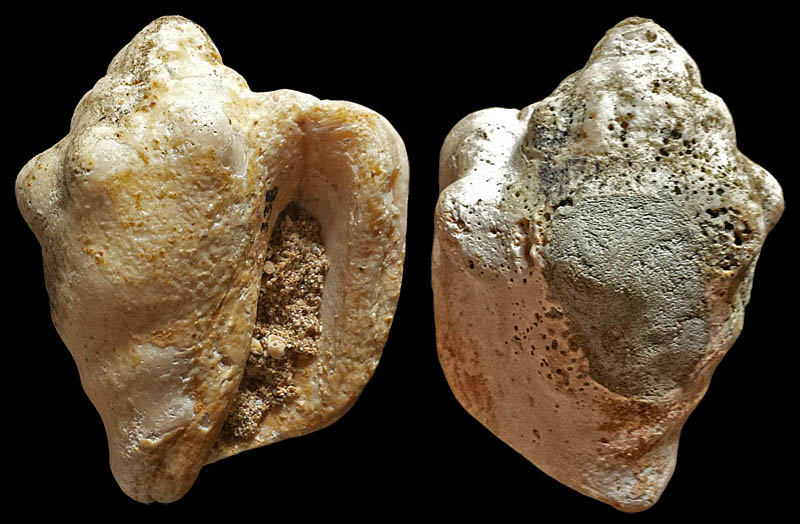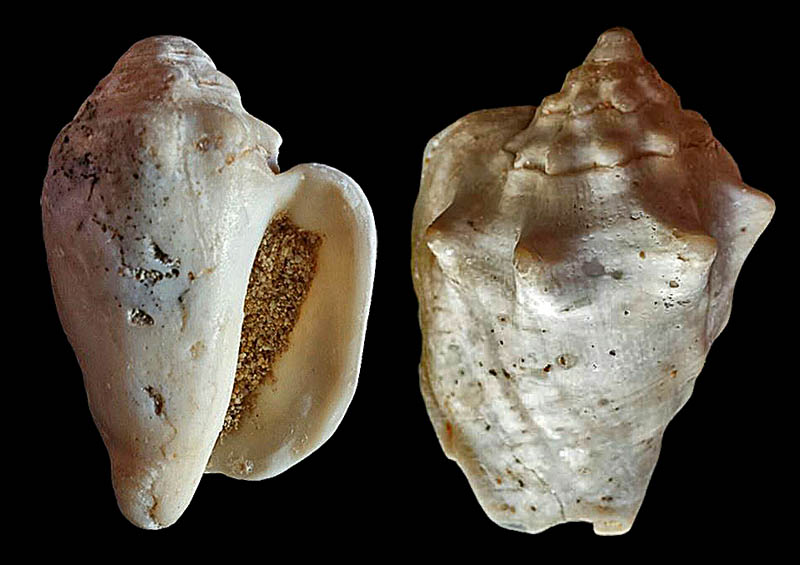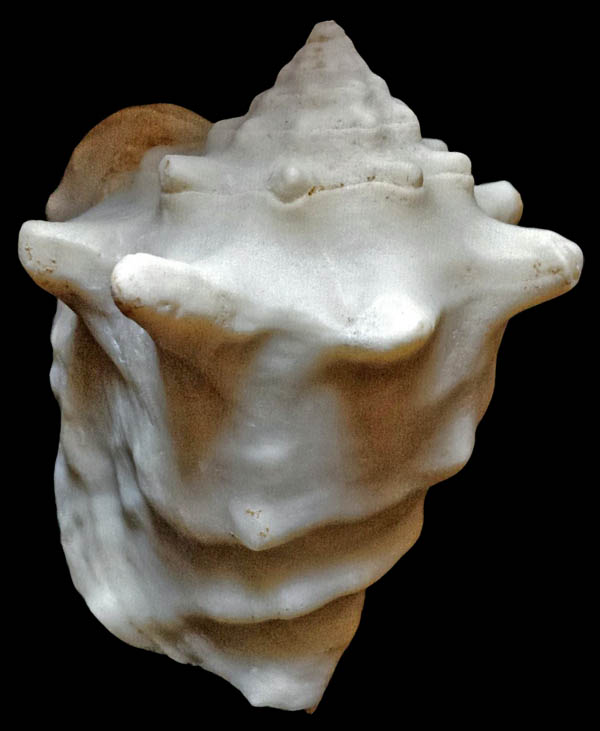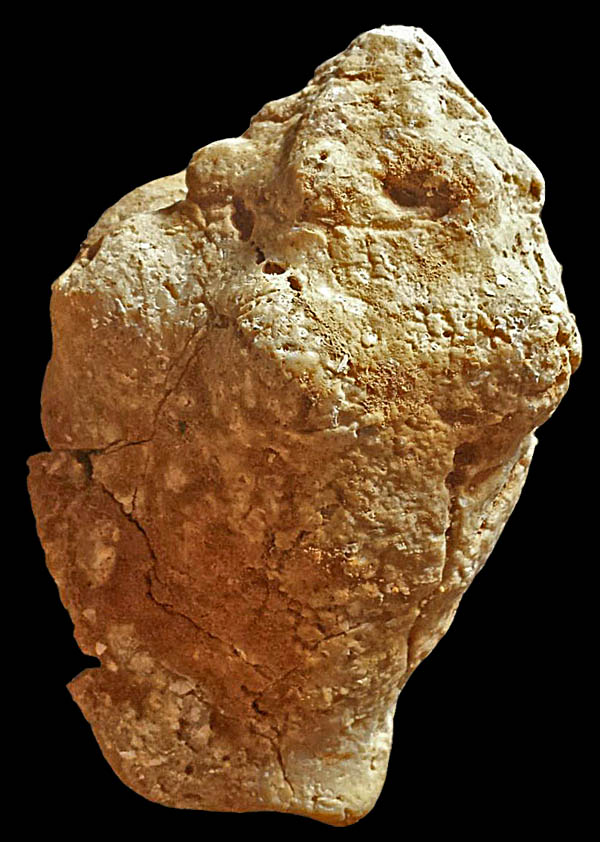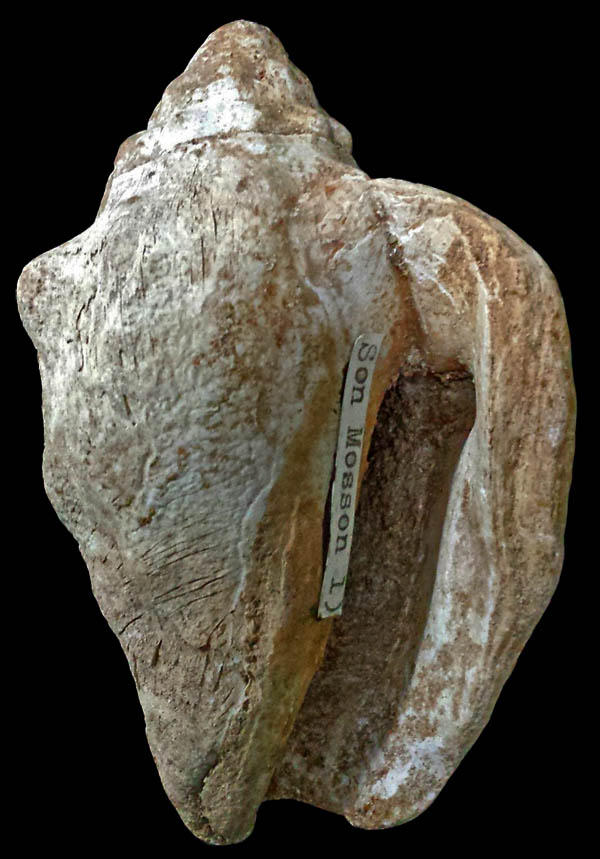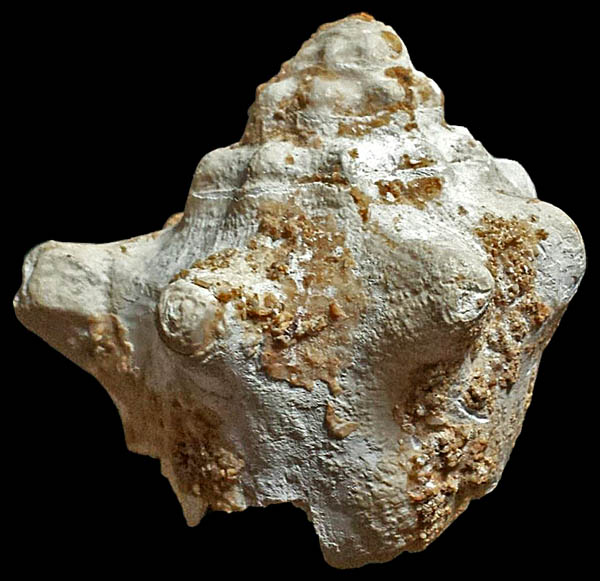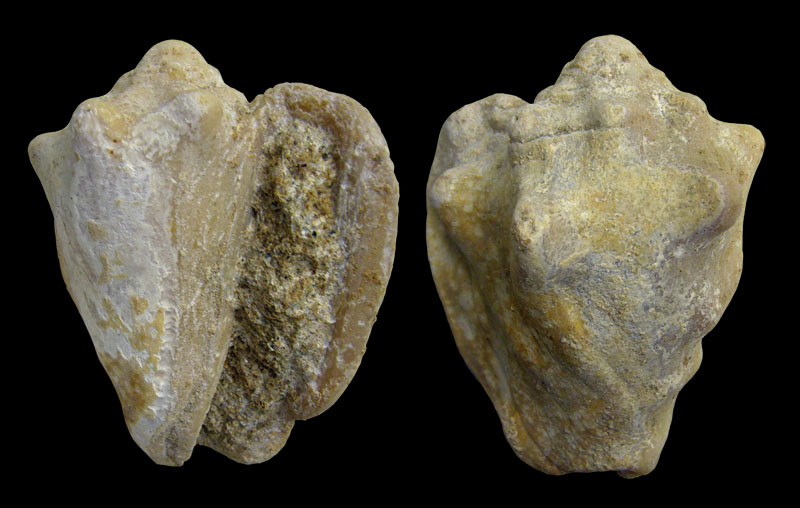Stromboidea
Original Description of Strombus latus by Gmelin, 1791, p. 3520:
- "latus. 35. Str. testae labro prominulo inferne bis emarginato, spirae anfractu primo medio laevi utrinque transversim striato, reliquis nodis obtusis coronatis. Habitat ---"
Gmelin, 1891:3520 cited:
- "Seb. mus. 3. t. 63. f. 4. 5."
Seba, 1758, pl. 63, fig. 4, 5
History and Synonymy
Persististrombus latus (Gmelin, 1791: 3520) (Strombus)
- Syn.: Strombus adansonii Defrance, 1827: 115
- Syn.: Strobus [err. pro Strombus] auratus Spalowsky, 1795: 43-44, pl. 6 fig. 9
- Syn.: Strombus bubonius Lamarck, 1822: 203
- Syn.: Lambis carnaria Röding, 1798: 64
- Syn.: Lambis carnea Röding, 1798: 63
- Syn.: Strombus dilatatus Lamarck, 1822: 203 [non Strombus dilatatus Swainson, 1821]
- Syn.: “Strombus epidromis L., 1758”. Willmann et al. in Müsch et al.: 570 [identification for Seba, pl. 63, figs 4, 5]
- Syn.: Strombus fasciatus Gmelin, 1791: 3510 [non Strombus fasciatus Born, 1778]
- Syn.: Strombus latus f. arenensis Bernard, 1982: 17 [unavailable; published as a varietal name after 1960, ICZN art. 15.2]
- Syn.: Strombus latus arenosus Rolán & Ryall, 1999: 28 [err. pro Strombus latus arenensis Bernard, 1982; nom. nud.]
- Syn.: Strombus latus f. minima Bernard, 1984: 38, pl. 9, fig. 43b. [unavailable; published as a varietal name after 1960 ICZN art. 15.2, junior homonym of Strombus minimus Linnaeus, 1771]
- Syn.: Strombus latus f. portgentilensis Bernard, 1984: 38, pl. 9, fig. 43d. [unavailable; published as a varietal name after 1960, ICZN art. 15.2]
- Syn.: Strombus mediterraneus Duclos, 1844: pl. 29, figs 4, 5
- Syn.: Strombus rosaceus Martyn, 1784: [not available, ICZN, 1957 opinion 456]
1757
Kalan Adanson, 1757, pl. 9, fig. F
Knorr, 1757, vol. 2, pt. 2, pl. 17, fig. 1
1758
Seba, 1758, pl. 62, fig. 6, 7, 8
1777
Martini, 1777, pl. 82, fig. 833, 834
Martini, 1777, pl. 91, fig. 893
1795
Original Description of Strobus [sic, err. pro Strombus] auratus (Die Goldzeug-Flügel-Schneke[sic]) by Spalowsky, 1795, p. 43:
- "Testa ovata, crassa, laevis, anfractibus septem nodoso-coronatis, dorso infimi cingulis duobus obsolete nodosis cincto, spira conica, labro grasso, supra parum prominente obtuso, infra bilobo, labio reflexo adnato lato tenui, basi effusa brevi."
- "Die Schale ist kurz exförmig, dick und glatt, die sieben Windungen sind mit Knoten gekrönt, der Rücken der untersten Windung ist noch überdies mit zwey etwas unmerklich knotigen Gürteln umgeben, der Zopf steigt kegelförmig in eine Spitze auf, die äußere Lippe ist dick. stumpf, oben wenig hervorragend, unten zweylappig, die Spindellippe überschlagen, angewachsen, ungleich ausgebreitet, aber dünn, die Basis kurz und buchtig ausgeschnitten."
- "Color aurantius, maculis flammeis albis. Ob similitudinem hujus picturae com opere phrygio aureo huic speciei nondum descriptae a nobis nomen auratae data est."
- "Farbe oraniengelb, mit weissen flammigen Flecken. Wegen der Ähnlichkeit dieser Gestalten mit einem goldnen Zeuge haben wir dieser noch nicht beschriebenen Art diesen Namen gegeben."
- "Patria: an India orientalis ?"
- "Vaterland: unbekannt; wahrscheinlich Ostindien."
- "Mensura: 4 poll. 4 lin. long. 3 p. lat."
- "Grösse: 4 Zoll 4 Linien lang, und 3 Z. breit."
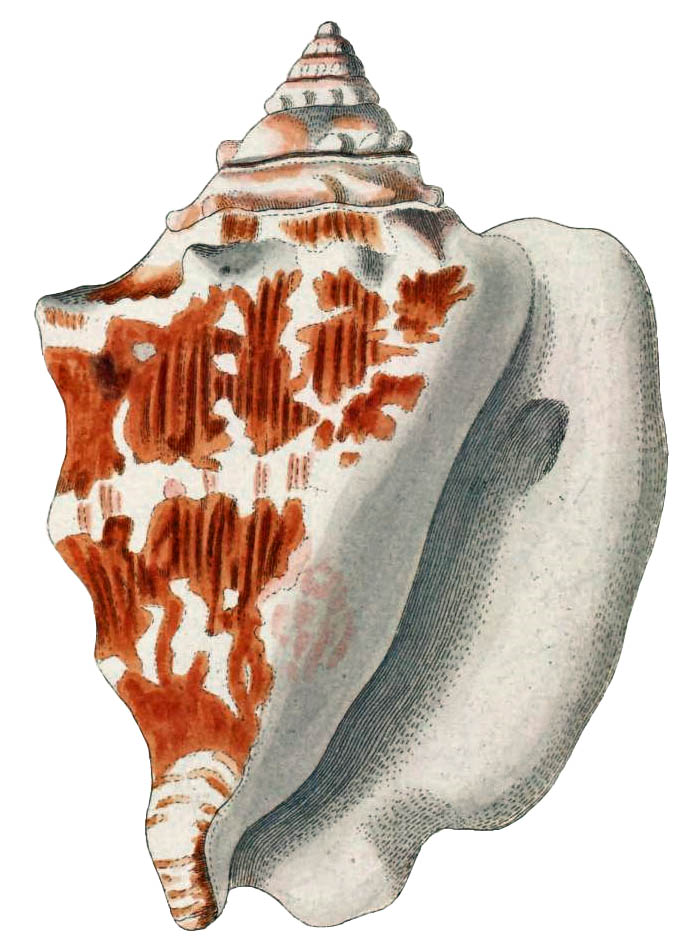
Strombus auratus (Die goldzeug Flügelschnecke) Spalowsky, 1795, pl. 6, fig. 9
1798
Original Description of Lambis Carnea by Röding, 1798, p. 63:
- "808 | 25 L. Carnea. Die hornigte Flügel-Schnecke. Gmel. stromb. fasciatus, sp. 9. Martini 3. t. 82. f. 833. 834. 8 St."
Original Description of Lambis Carnaria by Röding, 1798, p. 64:
- "809 | 26 L. Carnaria. Die Fleischfarbene Flügel-Schnecke. Gmel. stromb. fasciatus, sp. 9. Martini 3. t. 91. f. 893. 3 St."
1822
Lamarck, 1822, p. 203
Original Description of Strombus bubonius by Lamarck, 1822:
- "St. testa ovata, subturbinata, tuberculata et nodulifera, flavescente, albo-maculata, roseo-fasciata; spira conica, obtusiuscula, nodulosa, labrum superante."
- Locus typicus: "l'Océan des Antilles" (Lamarck, 1822)
1827
Description of Strombus latus by Defrance in Blainville, 1827, vol. 51, p. 115:
- "Le Strombe aile dilatée: S. latus, Gmel., p. 3520, n.° 35; Seba, Mus., 3, tab. 63, fig. 4 et 5. Coquille ovale-oblongue, renflée, lisse, ŕ spire assez courte, nodulifčre; bord droit dilaté, s'appuyant sur celle-ci, rude et un peu épaissi sous le bord. Couleur jaune avec trois séries de taches blanches. Patrie inconnue."
Original Description of Strombus Adansonii by Defrance in Blainville, 1827, vol. 51, p. 115:
- "Le S. Kalan; S. Adansonii, Sénég., page 137, pl. 9. Coquille épaisse, pesante, trčs-grande (huit ŕ neuf pouces de long sur quatre ŕ cinq de large), ŕ spire sillonnée, tuberculée, pointue et assez courte; le dernier tour onde et couronné de deux ŕ quatre rangs de tubercules plus gros sur le postérieur; bord droit épais, obtus, sans bourrelet, ne dépassant gučre le dernier tour, et sans crénelures ou digitations avant le sinus. Couleur fauve, ondée de marbrures blanches, quelquefois rouge sur les tubercules, sous un épiderme roux et assez mince."
- "Adanson, qui a trouvé cette espčce communément dans les rochers de l'île de Gorée sur la côte du Sénégal, fait une observation importante en disant que ce n'est que lorsqu'elle a atteint la grosseur de trois pouces, que le bord droit s'étend et s'épaissit, et que cependant parmi les coquilles de ce volume il y en a qui, comme les jeunes, ont le bord extręmement mince, tranchant , sans évasement et sans canal; ce qui leur donne un aspect tout particulier."
1843
Strombus dilatatus in Kiener, 1843, pl. ?
Strombus bubonius in Kiener, 1843, pl. ?
1844
Strombus bubonius in Duclos, 1844, pl. 12, fig. 3, 4
Strombus mediterraneus in Duclos, 1844, pl. 29, fig. 4, 5
1850
Strombus bubonius in Reeve, 1850, Strombus, pl. 12, fig. 27
1851
Strombus rosaceus Woodward, 1851:366
1885
De Gregorio, 1885 defines:
Strombus sferracavallensis De Gregorio, 1885:343
- Locus typicus: Sferacavallo near Palermo, Italy
- Stratum typicum: Pleistocene
1913
Strombus bubonius In Gignoux, 1913, pl. VI, fig. 1, 2, 3
- 1: "Couches ŕ Strombes de Tarente"
- 2, 3: "Couches ŕ Strombes de Ravagnese, prčs Reggio; individus jeunes"
2009
De Torres et al., 2009, p. 149:
- "Persististrombus latus Gmelin, 1791 is the most cited fossil gastropod from the Pleistocene marine-raised deposits of the Mediterranean realm. It has usually been referred to as Strombus bubonius Lamarck 1822, although Strombus latus Gmelin 1791 is the senior synonym. However, according to the recent taxonomic revisions of Strombus species undertaken by Kronenberg & Lee (2007) and Harzhauser & Kronenberg (2008), this gastropod is considered to belong to the genus Persististrombus.
- According to Cuerda (1987), the association of P. latus with other mollusc species constituted the Senegalese Faunal Complex, marking Mediterranean seawater warming during interglacial episodes along the Pleistocene, which corresponded to periods of high sea levels. In fact, today P. latus is restricted to the Eastern Atlantic Region, occurring in an area from the Rio d’Oro to Angola and limited in the north by the Canary Current and in the south by the Benguela Current. Its northern distribution borders are the Cape Verde Islands (Kreipl & Poppe 1999). An average temperature of 25°C favours this gastropod; however, it tolerates a temperature range from 16 to 31°C. Its average lifespan of 3–5 years is characterized by a cyclic growth rate, depending on the seasonality of the sea surface temperature.
- Due to its reproductive strategy, extant P. latus is a gregarious species (Stoner 1994; Mendes-Lopes 2002). The continuous presence of fossil P. latus lumachelle, a paucispecific tanatocoenosis linked to storm beach deposits, reinforces the notion that fossil P. latus inhabited shallow waters (Meco 1977).
- Extant P. latus inhabit sandy-muddy bottoms and seagrass meadows and follows detritivorous and vegetarian feeding strategies (Lozac’hmeur & Mascarenhas 1985), typically in waters with normal salinity (Guerreiro 1994; Guerreiro & Reiner 2000; Mendes-Lopes 2002). However, in the Gulf of Guinea, Meco (1977) found P. latus representatives in zones with freshwater input and consequently lower salinity. Although P. latus inhabits soft bottoms, our findings demonstrate that fossil P. latus also colonized rocky bottoms."
2014
Taviani, 2014, p. 9 about Persististrombus latus:
- "The Mediterranean basin lost its strombid fauna, at that time represented by the only taxon Persististrombus coronatus (Defrance, 1817), following the decline of its tropical/subtropical marine fauna in the Pliocene. In the Pleistocene, strombids re-entered the basin during warm interglacial times with the west-African P. latus (Gmelin, 1791). Its occurrence, however, was not cyclical, albeit short-lived, as one could expect by the repetitive modulation of glacial cycles. The successful establishment of P. latus was episodically instead and possibly limited to interglacials MIS5.5 and MIS7. One reason could be the lack of optimal thermal conditions during strombiddeprived integlacials. However, the observation that in the present interglacial (Holocene), conditions for the settlement of strombids are propitious in the Mediterranean as shown by the acclimatization of non-indigenous Conomurex species, while P. latus is absent, requires an additional explanation. It is likely that west-African taxa could only enter the Mediterranean at rare time when the Canary current barrier is sensibly abated."
Specimens from institutional collections
Persististrombus latus (Gmelin, 1791); 121 mm; Pleistocene, end of OIS5e; Molinar, Mallorca Island, Balearic Islands Province, Autonomous community of the Balearic Islands, Spain; record size for a complete specimen in Balearic; Coll. Cuerda in SHNB; Published in Cuerda (1975, 1987, 1989); Photo José Juárez Ruiz
Strombus coronatus Defrance, 1827; Larnaca, Larnaca District, Cyprus Island, Eastern Mediterranean; Coll. NHMW no. 1861/XLII/8
Strombus coronatus Defrance, 1827; Larnaca, Larnaca District, Cyprus Island, Eastern Mediterranean; Coll. NHMW no. 1861/XLII/10
Specimens from private collections
Persististrombus latus (Gmelin, 1791); Senegal, West Africa; Coll. Gijs Kronenberg no. 5404
Persististrombus latus (Gmelin, 1791); Senegal, West Africa; Coll. Gijs Kronenberg no. 5405
Persististrombus latus forma latus (Gmelin, 1791); Senegal, West Africa; 143 mm; Coll. José Juárez Ruiz
Persististrombus latus (Gmelin, 1791); 120 mm; Senegal, West Africa; Coll. José Juárez Ruiz
Persististrombus latus forma portgentilensis Bernard, 1984; Gabon, west coast of Central Africa; 97 mm; Coll. José Juárez Ruiz
- Comments by Virgilio Liverani: sorry I do not concur, the forma portgentilensis is more smooth on the dorsum, with pointed horns at shoulder, like the Pleistocene ones from Almeria.
Persististrombus latus (Gmelin, 1791); Săo Tomé and Principe Islands, Gulf of Guinea, Western equatorial coast of Central Africa; taken by fishermen in nets; 95 mm; 2001; Coll. Paul Merrill
Persististrombus latus (Gmelin, 1791); Boavista Island, Cape Verde Islands, Republic of Cabo Verde, Central Atlantic Ocean; 163 mm; Coll. José Juárez Ruiz
Persististrombus latus (Gmelin, 1791); Cape Verde Islands, Republic of Cabo Verde, Central Atlantic Ocean; 115 mm; Coll. Chong Chen
Persististrombus latus (Gmelin, 1791); Isla Sao Vicente, Cape Verde Islands, Republic of Cabo Verde, central Atlantic Ocean; 100 mm; Coll. Francesco Giovanoli
Persististrombus latus (Gmelin, 1791); Gabon, West Africa; on sand; 99 mm; Coll. Francesco Giovanoli
Persististrombus latus (Gmelin, 1791); Port-Gentil, Bendje Department, Ogooué-Maritime Province, Gabon, West Africa; 68 mm; Coll. Francesco Giovanoli
Persististrombus latus (Gmelin, 1791); Kribi, Ocean Department, South Province, Cameroon, West Africa; 101 mm; Coll. Francesco Giovanoli
Persististrombus latus (Gmelin, 1791); Conakry, Conakry Region, Guinea, West Africa; 105 mm; Coll. Francesco Giovanoli
Persististrombus latus (Gmelin, 1791); Port-Gentil, Bendje Department, Ogooué-Maritime Province, Gabon, West Africa; 99 mm; Coll. Francesco Giovanoli
Persististrombus latus forma arenensis Bernard, 1982; Mauritania, Maghreb Region, Western North Africa; found outside the known distribution; 124 mm; Coll. José Juárez Ruiz
Persististrombus latus (Gmelin, 1791); Pleistocene, OIS7a; Cerro Largo, Almería, Province of Almeria, Autonomous community of Andalusia, Spain; Coll. José Juárez Ruiz
- tl: 50 mm; juvenile
- tr: 60 mm; dwarf adult specimen
- b: 110 mm
Persististrombus latus (Gmelin, 1791); Pleistocene, OIS7a; Cerro Largo, Almería, Province of Almeria, Autonomous community of Andalusia, Spain; 95 mm; Coll. José Juárez Ruiz
Persististrombus latus (Gmelin, 1791); Pleistocene, OIS7a; Cerro Largo, Almería, Province of Almeria, Autonomous community of Andalusia, Spain; 53 mm; Coll. José Juárez Ruiz
Persististrombus latus (Gmelin, 1791); Pleistocene, OIS7a; Cerro Largo, Almería, Province of Almeria, Autonomous community of Andalusia, Spain; 91 mm; freak specimen with double tuberculation; coll. José Juárez Ruiz
Persististrombus latus (Gmelin, 1791); freak; Pleistocene; Spain; 90 mm; Coll. José Juárez Ruiz
Persististrombus latus (Gmelin, 1791); Pleistocene, OIS7a? (142 k.a.); Alicante, Province of Alicante, Autonomous community of Valencia, Spain; Coll. José Juárez Ruiz
- l: 91 mm, El Pinet
- r: 95 mm, Cabo Huertas
Persististrombus latus (Gmelin, 1791); Pleistocene, early OIS5e; Platja de Sant Joan, Mallorca Island, Balearic Islands Province, Autonomous community of the Balearic Islands, Spain; 105 mm; one of the best specimens found in the North of the island; Coll. José Juárez Ruiz
Persististrombus latus (Gmelin, 1791); Pleistocene, end of OIS5e; Camp de Mar, Mallorca Island, Balearic Islands Province, Autonomous community of the Balearic Islands, Spain; 82 mm; mostly complete young adult specimen; Coll. José Juárez Ruiz
Persististrombus latus (Gmelin, 1791); Pleistocene, end of OIS5e; Molinar, Mallorca Island, Balearic Islands Province, Autonomous community of the Balearic Islands, Spain; 77 mm; Coll. José Juárez Ruiz
Persististrombus latus (Gmelin, 1791); Pleistocene, end of OIS5e; Peguera, Mallorca Island, Balearic Islands Province, Autonomous community of the Balearic Islands, Spain; Coll. José Juárez Ruiz
- l: 82 mm; internal mould
- b: 60 mm
Persististrombus latus (Gmelin, 1791); Pleistocene, OIS5e; Peguera, Mallorca Island, Balearic Islands Province, Autonomous community of the Balearic Islands, Spain; 64 mm; Coll. José Juárez Ruiz
Persististrombus latus (Gmelin, 1791); Pleistocene, OIS5e; Las Rocas, Mallorca Island, Balearic Islands Province, Autonomous community of the Balearic Islands, Spain; 76 mm; Coll José Juárez Ruiz
Persististrombus latus (Gmelin, 1791); Pleistocene, OIS5e; Palmanova, Mallorca Island, Balearic Islands Province, Autonomous community of the Balearic Islands, Spain; t: 79 mm, b: 80 mm; Coll. José Juárez Ruiz
Persististrombus latus (Gmelin, 1791); Pleistocene, OIS5e; Camp de Tir, Mallorca Island, Balearic Islands Province, Autonomous community of the Balearic Islands, Spain; 104 mm; Coll. José Juárez Ruiz
Persististrombus latus (Gmelin, 1791); Pleistocene, OIS5e; Can Canals, Mallorca Island, Balearic Islands Province, Autonomous community of the Balearic Islands, Spain; 67 mm; Coll. José Juárez Ruiz
Persististrombus latus (Gmelin, 1791); Pleistocene, end of OIS5e; Can Vanrell, Mallorca Island, Balearic Islands Province, Autonomous community of the Balearic Islands, Spain; 86 mm; Coll. José Juárez Ruiz
Persististrombus latus (Gmelin, 1791); Pleistocene, end of OIS5e; Can Vanrell, Mallorca Island, Balearic Islands Province, Autonomous community of the Balearic Islands, Spain; 88mm; Coll. José Juárez Ruiz
Persististrombus latus (Gmelin, 1791); Pleistocene, end of OIS5e; Can Vanrell, Mallorca Island, Balearic Islands Province, Autonomous community of the Balearic Islands, Spain; 88mm; Coll. José Juárez Ruiz
Persististrombus latus (Gmelin, 1791); Pleistocene, end of OIS5e; Can Vanrell, Mallorca Island, Balearic Islands Province, Autonomous community of the Balearic Islands, Spain; 87mm; morphotype with very high spiral, close to forma arenensis; Coll. José Juárez Ruiz
Persististrombus latus (Gmelin, 1791); Pleistocene, end of OIS5e; Punta Tinent (label as Cala Blava), Mallorca Island, Balearic Islands Province, Autonomous community of the Balearic Islands, Spain; 97 mm; found in the 1950's; Cuerda-collection in SHNB; photo José Juárez Ruiz
Persististrombus latus (Gmelin, 1791); Pleistocene, end of OIS5e; Punta Tinent, Mallorca Island, Balearic Islands Province, Autonomous community of the Balearic Islands, Spain; 82 mm; Coll. José Juárez Ruiz
Persististrombus latus (Gmelin, 1791); juvenile specimen; Pleistocene, end of OIS5e; Mallorca Island, Balearic Islands Province, Autonomous community of the Balearic Islands, Spain; 124 mm; Coll. José Juárez Ruiz
Persististrombus latus (Gmelin, 1791); Tyrrhenian, Pleistocene; ca 400 m long strip of small cliffs along the coastline, East of Sfax, Tunisia; Coll. Antoine Heitz no. 3376
Persististrombus latus (Gmelin, 1791); Pleistocene; Corinth Canal area, Greece; Coll. Antoine Heitz No. 2299
Persististrombus latus (Gmelin, 1791); juvenile specimen; Pleistocene, OIS5e; Karpathos Island, South Aegean Region, Greece; 57 mm; Coll. José Juárez Ruiz
Persististrombus latus (Gmelin, 1791); Pleistocene, OIS5e; Regio Calabria, Italy; 88 mm; Coll. José Juárez Ruiz
Persististrombus latus (Gmelin, 1791); Pleistocene, early OIS5e (135 ka); Jandia, Fuerteventura Island, Canary Islands, Spain; 109 mm; Coll. José Juárez Ruiz
Persististrombus latus (Gmelin, 1791); Pleistocene, early OIS5e (135 ka); La Guirra, Fuerteventura Island, Canary Islands, Spain; 125 mm; Coll. José Juárez Ruiz
Persististrombus latus (Gmelin, 1791); Pleistocene, OIS 5e (135 ka); Matagorda, Lanzarote Island, Canary Islands, Spain; 128 mm; Coll. José Juárez Ruiz
Persististrombus latus (Gmelin, 1791); Pleistocene, end of OIS5e (?); San Andrés, Tenerife Island, Canary Islands, Spain; 69 mm; Coll. José Juárez Ruiz
Persististrombus latus (Gmelin, 1791); Pleistocene, OIS 5e; San Cristobal, Gran Canaria Island, Canary Islands, Spain; Morphotype with rare divided peristome present in some specimens from Canary Islands but never seen in Mediterranean ones; 113 mm; Coll. José Juárez Ruiz
Persististrombus latus (Gmelin, 1791); Pleistocene, probably OIS5c (100 k.a.); Carnatge (U3), Mallorca Island, Balearic Islands Province, Autonomous community of the Balearic Islands, Spain; 69 mm; Coll. José Juárez Ruiz
Persististrombus latus (Gmelin, 1791); Pleistocene, probably OIS5c (100 k.a.); Carnatge (U3 or U4), Mallorca Island, Balearic Islands Province, Autonomous community of the Balearic Islands, Spain; 100 mm; Coll. Cuerda in SHNB; Photo José Juárez Ruiz
Persististrombus latus (Gmelin, 1791); Pleistocene, early OIS5e (135 k.a.); Carnatge (U1), Mallorca Island, Balearic Islands Province, Autonomous community of the Balearic Islands, Spain; 110 mm; Coll. José Juárez Ruiz
Persististrombus latus (Gmelin, 1791); Pleistocene, early OIS5e (135 k.a.); Carnatge (U1), Mallorca Island, Balearic Islands Province, Autonomous community of the Balearic Islands, Spain; 105 mm; Coll. José Juárez Ruiz
Persististrombus latus (Gmelin, 1791); Pleistocene, end of OIS5e (117 k.a.); Carnatge (U2), Mallorca Island, Balearic Islands Province, Autonomous community of the Balearic Islands, Spain; slighly restored; 100 mm; Coll. José Juárez Ruiz
Persististrombus latus (Gmelin, 1791); Pleistocene, end of OIS5e; Punta Negra, Mallorca Island, Balearic Islands Province, Autonomous community of the Balearic Islands, Spain; Coll. José Juárez Ruiz
- l: 65 mm; eroded adult specimen with anormal peristome, result of cicatrizated damage
- r: 70 mm; small adult with the normal size of the population represented in the locality
Persististrombus latus (Gmelin, 1791); Pleistocene, end of OIS5e; Mallorca Island, Balearic Islands Province, Autonomous community of the Balearic Islands, Spain; typical portgentilensis specimen; 93 mm; Coll. José Juárez Ruiz
Persististrombus latus (Gmelin, 1791); Pleistocene, end of OIS5e (probably 117 k.a.); Son Mosson, Mallorca Island, Balearic Islands Province, Autonomous community of the Balearic Islands, Spain; 97 mm; Coll. José Juárez Ruiz
Persististrombus latus (Gmelin, 1791); Pleistocene, end of OIS5e (most probably 117 k.a.); Son Mosson, Mallorca Island, Balearic Islands Province, Autonomous community of the Balearic Islands, Spain; 110 mm; Coll. Cuerda in SHNB; Photo José Juárez Ruiz
Persististrombus latus (Gmelin, 1791); Pleistocene, OIS5e; near Cala Gamba, Mallorca Island, Balearic Islands Province, Autonomous community of the Balearic Islands, Spain; incomplete adult slized during geological probing in the 60's; 60 mm; Coll. Muntaner; Photo José Juárez Ruiz
Strombus bubonius Lamarck, 1822; Tyrrhenian, 97.000 years old, Pleistocene; San Juan de los Terreros, Almeria, Province of Almeria, Autonomous community of Andalusia, Spain; 82 mm; Coll. Aart Dekkers no. STR9063
References:
- Abatino, E., Barbera Lamagna, C. & Boni, M. 1971: Ultrastruttura e composicione chimica del guscio di Strombus bubonius Lk. (=S. Latus Gm) viventes e fossile. Rendiconto dell’Accademia delle Scienze Fisiche e Matematiche di Napoli, Serie 4(XXVIII), 1–17.
- R. T. Abbott and S. P. Dance (1986)
- Adanson, M. 1757. Histoire naturelle de Senegal: coquillages; avec la Relation abrégée d'un Voyage fait en ce pays, pendant les années 1749, 50, 51, 52 & 53 ; Ouvrage orné de Figures; Bauche, Paris
- P. Arduini and G. Teruzzi (1986)
- Arnaud, P. M., 1977
- Cornu, S., Pätzold, J., Bard, E., Meco, J. & Cuerda-Barceló, J. 1993: Paleotemperature of the last interglaciar period based on d18O of Strombus bubonius from the western Mediterranean Sea. Palaeogeography, Palaeoclimatology, Palaeoecology 103, 1–20.
- Cuerda, J. 1975. Los Tiempos cuaternarios en Baleares. Pub. Instituto Estudios Balearicos. Dip. Prov. Baleares 304 p., 50 fig. Palma de Mallorca
- Cuerda, J. 1987: Moluscos Marinos y Salobres del Pleistoceno Balear, 421 pp. Caja de Baleares ‘Sa Nostra’, Mallorca.
- G. Dai Pra, G. Magri and A. Spada (1974)
- S. P. Dance and R. von Cosel (1977)
- Ph. Dautzenberg (1891)
- De Gregorio, 1885
- De Torres T., Ortiz J.E., Puche O., de la Vega R. & Arribas I. (2006) - Biometría de Strombus bubonius Lamark 1791 del yacimiento de Cerro Largo (Roquetas de Mar, Almería). Geogaceta, 40, 167-170.
- De Torres, T., Ortiz, J.E., Arribas, I., Delgado, A., Juliŕ, R. & Martín-Rubí, J.A. 2009: Geochemistry of Persististrombus latus Gmelin from the Pleistocene Iberian Mediterranean realm. Lethaia, Vol. 43, pp. 149–163. URL
- G. P. Deshayes (1866)
- J. M. Eisenberg (1983)
- A. Falconieri (1996)
- P. Fischer (1880 - 1887)
- F. Fontannes (1879-1880)
- M. M. Gignoux (1911)
- Gignoux, M. (1913) - Les formations marines pliocčnes et quaternaires de l'Italie du Sud et de la Sicile. Thčse sc. Lyon, n° 53. Link
- M. Glibert (1963)
- González-Delgado, J.A., Zazo, C., Goy, J.L., Hoyos, M., Civis, J. & Dabrio, C.J. 1998: Variaciones estacionales en Strombus bubonius cuaternarios de Fuerteventura (Isals Canarias) a partir de perfiles de isótopos estables de C y O. XIV Jornadas de Paleontología, Tenerife-La Laguna, 88–92.
- González-Delgado, J.A., Goy, J.L., Zazo, C., Civis, J. & Dabrio, C.J. 2000: Perfiles de isótopos estables de C y O en Strombus actuales, cuaternarios y pliocenos. XVI Jornadas de Paleontología, Evora, 89–90.
- H.-J. Gregor, A. E. Richter and E. Velitzelos (1998)
- Guerreiro, A. 1994: Especial conchas deCabo Verde. Pesca e Mar 1, 16–18.
- Guerreiro, A. & Reiner, F. 2000: Moluscos Marinhos da Ilha de Sao Vicente (Archipélago de Cabo Verde), 279 pp. Câmara Municipal de Oeiras, Portugal.
- M. Harzhauser, A. Kroh, O. Mandic, W.E. Piller, U. Göhlich, M. Reuter, B. Berning, 2007. Biogeographic responses to geodynamics: A key study all around the Oligo–Miocene Tethyan Seaway, Zoologischer Anzeiger - A Journal of Comparative Zoology, Volume 246(4), Pages 241-256
- Harzhauser, M. & Kronenberg, G. 2008: A note on Strombus coronatus Defrance, 1827 and Strombus coronatus Röding, 1798 (Mollusca: Gastropoda). The Veliger 50, 120–128.
- Harzhauser, M. & Kronenberg, G.C. 2013. The Neogene Persististrombus-lineage (Gastropoda: Strombidae) in the Paratethys Sea. – Acta Palaeontologica Polonica 58 (4): 785-802
- Hillaire-Marcel C., Carro O., Causse C., Goy J.-L. & Zazo C. (1986) - Th/U dating of Strombus bubonius-bearing marine terraces in southeastern Spain. Geology, 14, 613-616.
- C. Karnekamp (1985)
- G. Kronenberg and J. Berkhout (1984)
- G. C. Kronenberg and H. G. Lee (2007)
- B. Landau, R. Marquet and M. Grigis (2004)
- Lozac’hmeur, J.H. & Mascarenhas, A. 1985: Pesca Artesanal – Equipamentos e Materiais de Pesca. Reflexoes Sobre a Pesca em Cabo Verde Praia, 499 pp. Secretaria de Estado das pescas, Praia.
- A. Malatesta (1974)
- J. Meco Cabrera (1975)
- Meco, J. (1977). Los Strombus neógenos y cuaternarios del Atlántico euroafricano. Taxonomía, biostratigrafia y paleoecología. Paleontología de Canarias. Ediciones Cabildo de Gran Canaria, 207p.
- Meco, J. 1977: Paleontología de Canarias, 142 pp. Excelentísimo Cabildo Insular de Gran Canaria, Gran Canaria.
- A. Mellini (1985)
- Mendes-Lopes, R.C. 2002: Caracterizacao da Pesca de Búcio-cabra (Strombus latus Gmelin, 1971) na Ilha de Sao Vicente, Cabo Verde, 44 pp. Unpublished MS Thesis, University of El Algarbe.
- R. Moscatelli (1987)
- Ronald Nalin, Valentina Alice Bracchi, Daniela Basso, and Francesco Massari, 2012. Persististrombus latus (Gmelin) in the upper Pleistocene deposits of the marine terraces of the Crotone peninsula (southern Italy); Italian Journal of Geosciences, February 2012, v. 131:95-101, doi:10.3301/IJG.2011.25
- Rolan, 2005
- F. Sacco (1893)
- Fr. Schlüter (1838)
- G.B. Sowerby (II) (1842-) 1847-1887
- Stoner, W.A. 1994: Significance of habitat and stock pre-testing for enhancement of natural fisheries: experimental analyses with queen conch Strombus gigas. Journal of the World Aquaculture Society 25, 155–165.
- Taviani, M. 2014. Unpersisting Persististrombus: a Mediterranean story; VIERAEA 42: 9-18.
- H. von Ihering (1907)
- E. Vredenburg (1925)
- J. G. Walls (1980)
- Woodward, S.P. 1851. Manual of the Mollusca; or, A rudimentary treatise of recent and fossil shells; London, William Ostell; i-xvi, 1-486, pls. 1-24, 1-24, URL
- C. Zazo, J.L. Goy, C. Hillaire-Marcel, C.J. Dabrio, J.A. González-Delgado, A. Cabero, T. Bardají, B. Ghaleb, V. Soler, 2010. Sea level changes during the last and present interglacials in Sal Island (Cape Verde archipelago), Global and Planetary Change, Volume 72(4), p. 302-317.

